|
Here follow various other non-folding cameras in my collection that don't have their own page, in somewhat arbitrary but roughly chronological order.
Ernemann Box
Ernemann was a camera manufacturer in Dresden, one of the camera hotspots in the 20th century. The company was most well known for its fast (and rather large) lenses, such as the magnificent 125 mm f/1.8 Ernostar mounted on its Ermanox plate camera. It was also famous for its tower, the Ernemannturm, which was a famous landmark in Dresden and became the well-known logo of VEB Pentacon in the 1950s. Ernemann was amalgamated into the new company Zeiss Ikon in 1926.
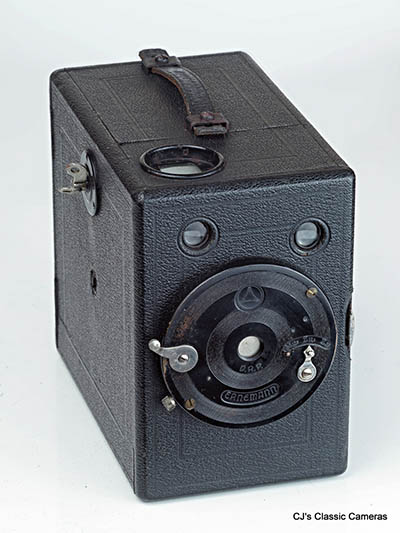 | |
I am not a great fan of box cameras, and this Ernemann Box is in fact the only one I've bought specifically. Admittedly, this was after seeing a beautiful wooden box camera which was an Ernemann Box from which the leather had been removed and had been polished and lacquered. I intended to do the same, but after cleaning it up I felt bad about peeling the leather off, as it was in such good condition, so now I am stuck with it as it is.
|
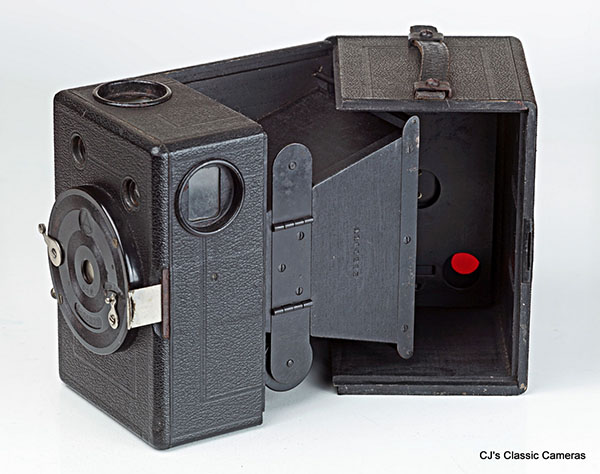
An Ernemann Box opened up. The way it hinges was quite unusual, for most box cameras one pulled out the film part from the back. The benefit of the Ernemann configuration is that the camera is one unit, which is more sturdy and ensures a consistent distance between lens and film plane.
Kochmann Korelle K
Kochmann was a small camera company from Dresden probably best known for its Korelle folding cameras and the Reflex Korelle, a medium format SLR. The company was founded in 1921 but most camera models were made in the 1930s.
The Korelle K was a bakelite half-frame camera introduced around 1932. It made 24x18 mm exposures on 35 mm film. It was small and handsome, looking more modern that its age suggests. It was one of the first cameras to be made from bakelite, preceding for instance the Argus A and Coronet Midget. It was fully featured with frame counter (up till 80!), body-mounted shutter release and double exposure prevention. One could easily believe this was build twenty years later.
It is a rather rare camera, illustrated by the fact that a Google search showed more links to auction houses than to eBay. Nevertheless, the latter is where the example below came from.
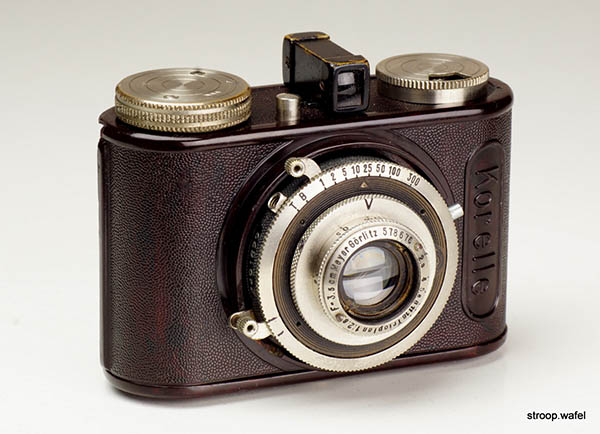
A Korelle K with Meyer Görlitz Trioplan 35/2.8 lens. Note that the lens is fixed and does not pull out as one might perhaps think.
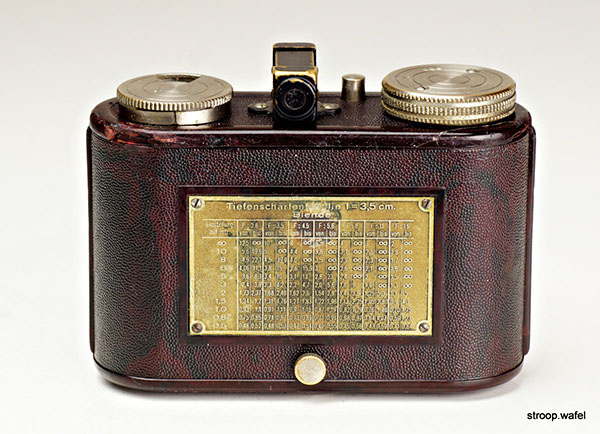
Rear view of a Korelle K with a worn depth of field table. To open the back one would need to unscrew the small knob at the bottom, and then push it in. This would release a latch on the inside which allowed the back to slide down.
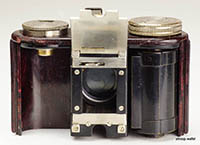
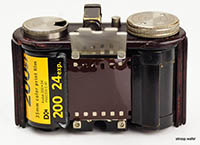
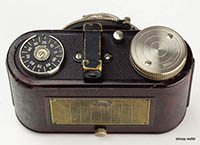
(left) Rear view of a Korelle K with back plate removed, showing the half-frame film gate and a uptake cassette. I imagine it originally came with a supply cassette also. (middle) Loaded with film. Yes it fits standard 35mm film rolls, which had not yet been invented when this camera was made! (right) Top view showing the frame counter with its cover removed. I wonder if one really would be able to shoot a 100 photos using reloadable cassettes?
Super Eljy Lumière
The Eljy by Lumière from Lyon, France, was a tiny subminiature camera. It is the smallest camera to take 36x24 photos that I know off, even smaller than the Boltavit which took smaller 24x24 mm negatives. The Eljy used its own type rollfilm, but unlike the Boltavit, it unfortunately cannot not be adapted to 135 film as the Eljy wind spool is only 30 mm high.
Despite its diminutive size the Eljy was a fully featured camera: it has a regular shutter and lens outfit with front-cell focus lens, a wide range of available apertures and a remote shutter release socket, a fold-up viewfinder which featured correction for parallax (!), and a tripod bush at the base. The only thing missing was an accessory shoe.
The Eljy was first introduced around 1937. The adjective 'Super' was used for Eljys with chrome trim, which were most post-war models. The main changes between different versions were with the shutter, which would get increasingly faster speeds, a separate cocking lever and a flash socket.
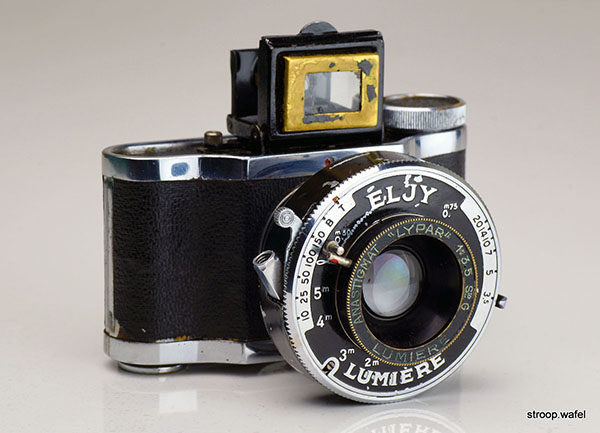
A 1945 Lumière Eljy with Anastigmat "Lypar" f/3.5 of unspecified focal length. The top speed of the shutter on this model was 1/150s. The aperture scale is rather peculiar, showing the uncommon markings 5, 7, 10, 14 and 20. Perhaps only logical though, as the fastest aperture was f/3.5, so all setting are equally separated by one stop.
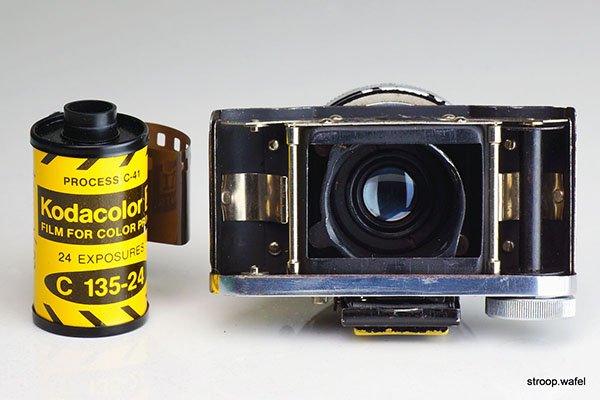
Inside of Lumière Eljy showing the 36x24mm lens gate and 30mm wind spool with a 135 film for comparison. Even though the Eljy took negatives of the same size as 135 film, one couldn't use the film as the spool was too small. The Eljy used dedicated rollfilm which was essentially 135 film without the perforations strips but with backing paper.
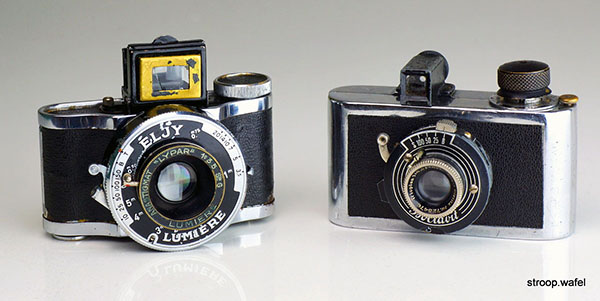
The Eljy side by side with another subminiature camera, the Boltavit. Both are about the same size but the Eljy took larger pictures.
Eljy Lumière Club
The Eljy Club by Lumière was the successor of the Eljy above and used the same specialty rollfilm. It was an improvement in various ways, most importantly it featured an extinction meter, which is a lightmeter based on how many of increasingly dark letters one can see against a dark background. A guide how to use it could be found on top of the camera. It also had an improved shutter which included slow speeds down to 1s as well as a top speed of 1/300. Finally, the red window at the back was no longer needed as the wind knob would showed how far to advance the film for the next frame. The lens was still collapsible and the camera was very compact.
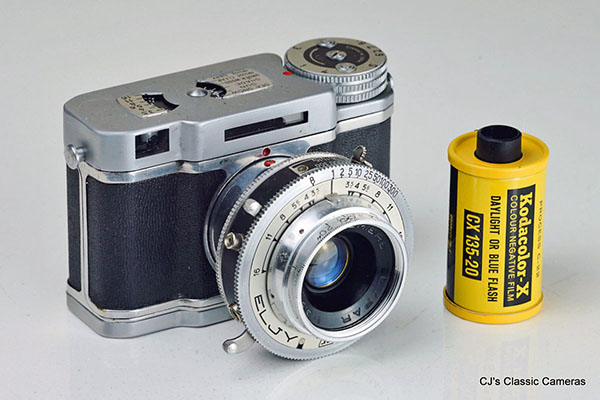
A Lumière Eljy Club with Lypar 40mm f/3.5 lens. The film cartridge is to illustrate the size of the camera only, as it used its own format rollfilm.
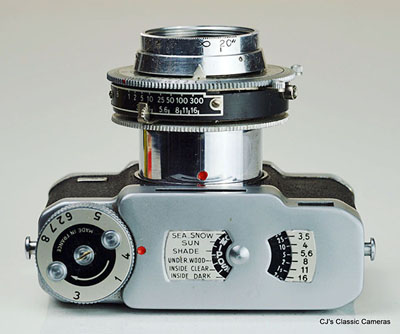
| |
Top view of the Lumière Eljy Club showing the exposure guide. The extinction meter showed the letters LUMIPOSE, then one could rotate the guide to match the letter for the appropriate lighting conditions , and read the exposure. Also note the frame numbers on the wind knob, which look quite random, but are spaced based on the fact that the film spool needs be wound less the more film has already been wound onto it.
|
Pontiac Baby-Lynx
Pontiac was a French camera maker based in Paris which made a range of cameras, including the Baby-Lynx shown here, as well as several other 'Lynx' cameras which were all similarly styled but with different specifications (see also Lynx II). The Baby-Lynx was a relatively simple camera with a fixed viewfinder and a collapsible lens with a Prontor II leaf shutter as commonly found on cameras from that era. Like the rest of the Lynx family it had an aluminium body but did have a leatherette body cover. Late production was made in Morocco, so watch the wind knob to see if it was made there or in France.
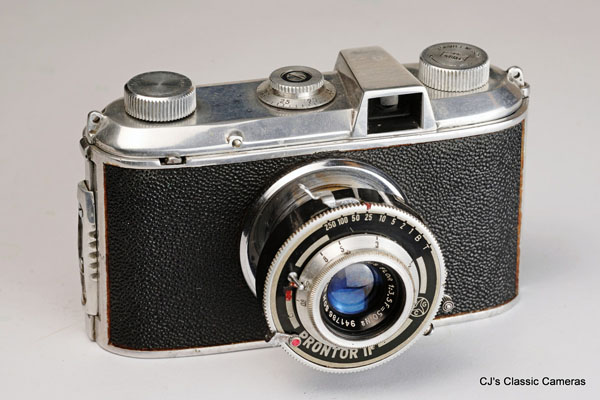
A French-made Pontiac Baby-Lynx with coated SOM Berthiot Flor 50mm f/3.5 lens. In name this is the same lens as on the 3x4 format Lynx II, but I can't say if it's indeed the same lens or has a different optical formula. This version is front-cell focussing in any case.
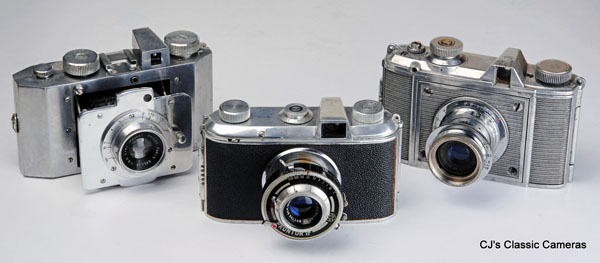
The Three Musketeers: three French cameras, two by Pontiac, one by Gallus, all characterised by a distinctive style with polished aluminium bodies and bold lines. Both cameras behind the Baby-Lynx are 3x4 format cameras with focal plane shutters, to the right the Pontiac Lynx II, to the left the Gallus Derlux.
OPL Foca **
The OPL Foca were a range of French screw-mount Leica copies made in the late 1940s and early 1950s. The various models were indicated by stars (indicated on the small name plate at the front of the camera), the two-star version show below had a coupled rangefinder, the * was a viewfinder camera, and the *** was a rangefinder camera with a slow-speed dial. Indeed, equivalent to the Leica II, I and III, respectively. And like the Leicas, the Focas had focal plane shutters, interchangeable lenses and removable backs. The layout of the controls was also clearly very similar to those on Leicas, but the Foca was instantly recognizable by its square rangefinder windows and its rather wide but thin body. It was available with a decent range of lenses, including a fast f/1.9 Oplarex standard lens.

An OPL Foca ** with interchangeable and retractable Oplar 50 mm f/3.5 lens. The rangefinder's semitransparent mirror was not simply a silvered glass slide, but consisted of two prisms glued togther into a cube with a silver coating on one of the prism's diagonal surface. As it was fully encolsed by glass this prevents it from staining, but unfortunately the silver in my example had deteriorated nonetheless and needed recoating. A big task as it requires separating and reglueing the prisms.
(left) Top view of the OPL Foca ** (right) Detailed view of the lens mount including the rather unusual depth of focus scale indicator. The lens itself was at least visually a close copy of the Leitz Elmar.
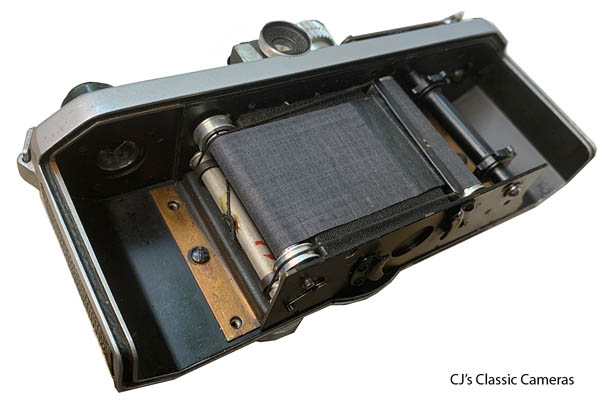
Focal plane shutter of the Foca with the cradle around the shutter removed. Interestingly, the shutter tape was made of wire, not a construct I have seen often, although the Corfield Periflex I had it too. Velvety cloth underneath the wire prevented it from scathing and breaking. Also note the quite coarse rubberised fabric making up the shutter blinds. Overall a pretty reliable shutter and easy to service.
Adloff Tex
The Adloff Tex was a subminiature camera designed to use unperforated 35mm film. It was quite similar to the Boltavit/Photavit elsewhere on this site. Both were small cameras using 35mm film, had telescoping lenses and a single viewfinder in the middle of the camera, as well as a removable back. However, whereas the Photavit had a square 24x24 film frame, the Tex had an impressive 40x30 mm frame size.
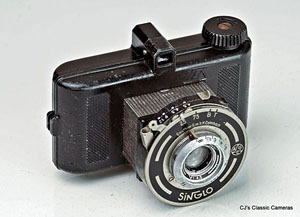
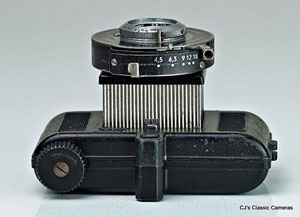
An Adloff Tex with Anastigmat Heliur f/4.5 lens in Singlo shutter, the most common lens-shutter combination the Tex is found with. Therefore you can often find this camera as the 'Singlo Tex'. The Singlo shutter was a self-cocking shutter with no double exposure prevention and only two shutter speeds (1/25 and 1/75s) plus B and T settings. It was produced by Gauthier, who also made the Prontor shutter range.
Not much information is available about this camera or its producer, Erwin Adloff from Berlin. A very similar camera with a different shutter and a double telescoping lens mount was sold as the Nova. Apparently both were designed by Fritz Kaftanski, who also designed other subminiature cameras such as the Minifex, the Sida and the Fex, which indeed show similar features. These were all sold by different companies so I get the impression that Kaftanski designed the cameras and then found manufacturers to produce them. It does not appear that Erwin Adloff had any further involvement in photography after the Tex. Information on production years is contradictory, but most likely the Nova was produced just before WWII, and the Tex just after.
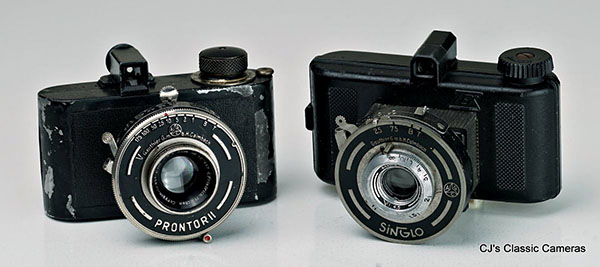
Adloff Tex and Boltavit II side by side. The Tex was only slightly larger, but had a much larger frame size.
Both the Tex and the Nova used the same dedicated film cassettes. The wind mechanism was quite interesting and different than any other system I have seen. At the back of the camera is a small window. A slider in the back of the camera switches this from a green to a red window. This has no particular function, so I assuming that green meant that the camera was empty and could be safely opened. Behind the little window is a small roller which has a white dot on it. When the film is transported the roller rotates and the film needs to be advanced until the white dot appears in the red window. A short white stripe appears just before the dot as a warning it is coming into view, just like markers on rollfilm. This system guarantees even film spacing throughout, but had the drawback that it had no frame counter.
As said, the camera was designed to be used with unperforated film, as the film frame was an impressive 40x30 mm, so similar to 127 film, and larger than the space between the perforations on regular 35mm film.
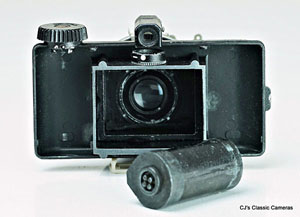
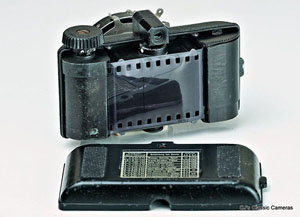
Rear view of the Adloff Tex with the back removed, showing the frame roller used for film advance. Also shown are the dedicated film cassettes.
Sida
The Sida was a tiny subminiature camera for use with 35mm roll film, similar to 828 film but a different spool specific for the Sida. It was made by Fritz Kaftanski's (of Minifex fame) Sida GmbH of Berlin, or at least, the original metal version was. The example shown here was made in England according printing on the back, in the late 1930s. It had a bakelite body and a simple meniscus f/8 lens. It had a knob to wind film, a lever to fire the shutter and another lever to switch to T exposure mode, and that was about it. On the back it had a red spy window to monitor advancing the film. A range of slightly different models exists, made in different countries at different times, but all very recognisable as part of the Sida family.
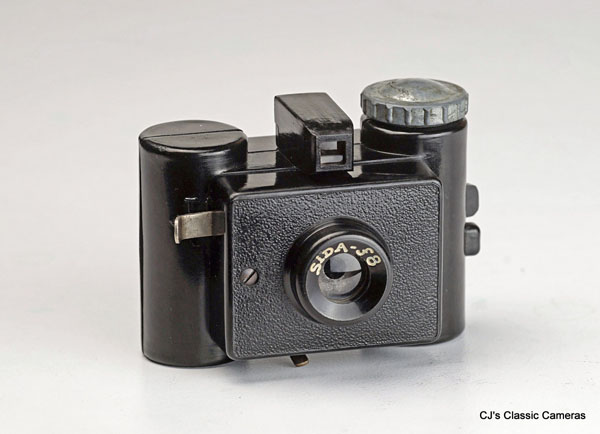
Sida camera with 35mm f/8 lens. The viewfinder looks like it is mounted the wrong way around, but that's how it is.
Elop Elca
The Elop Elca was a small square 24x24mm 35mm camera introduced in 1949 by Electro Optik GmbH from Flensburg, Germany. As the name indicated, the company also made electrical products including radios. As common at the time, the name Elca was a combination of the first part of the company and the word 'camera'. It was a small company, but it had an interesting history. It was founded by Franz Robert Neubert, who initially just after WWII started designing Leica copies in Jena (of Carl Zeiss fame), including the Neuca and Neucaflex. Soon after, however, Neubert moved to Western Germany to found Elop Gmbh, initially based in Glucksburg, and from 1948 in Flensburg. The first camera under the Elop brand was the Elca, which then evolved into the Elca II. Unfortunately, the company went bankrupt around 1950, but was restarted as UCA Vereinigte Optische Werke in 1951 (see below, Elca II).
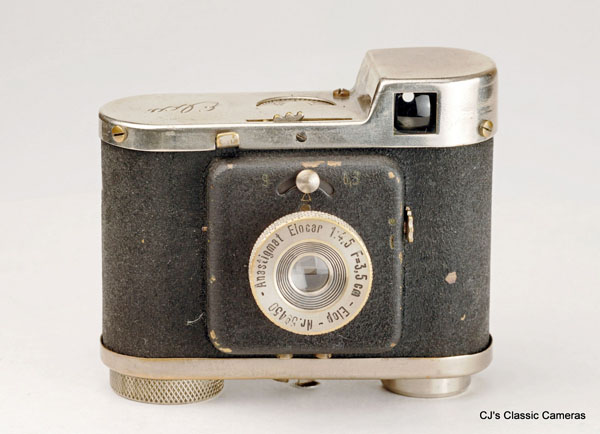
Elop Elca with Anastigmat Elocar 35mm f/4.5 lens. The button above the lens is the aperture control, one can just distinguish the 9 and 6.3 markings on either side. The lever to the right of the lens is the shutter speed control, switching from B to instantaneous, presumably about 1/30s.
The Elca was a very small camera, in fact one of the smallest 35mm cameras I know. It has quite a distinctive look with its raised viewfinder on top and a square shutter housing protruding at the front. So ugly it's almost cute?
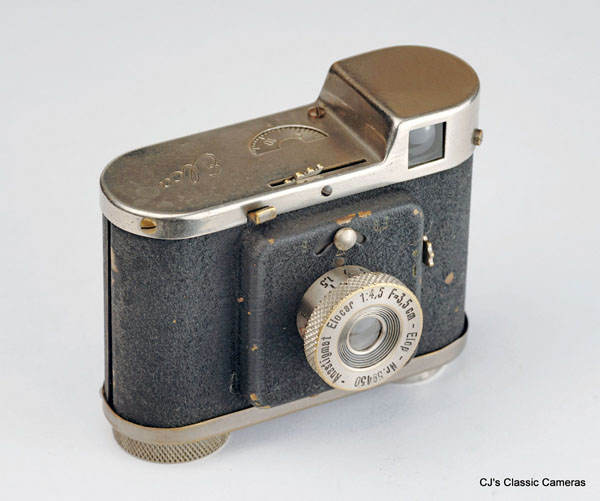
|
|
The camera was basic but did feature a unit-focussing lens and had two aperture settings as well as two shutter speeds. The shutter release was rather unusual, it was a small, toothed lever sticking out from the top housing and the shutter would fire by pushing it from right to left or left to right. I'd imagine camera shake would be difficult to avoid, and it's literally painful to use.
|
The Elca did not have a rewind knob, so it needed a take-up cassette to be used. The cassettes I tried did fit so well as the opening slit for the film to enter would sit slightly depressed relative to the film gate, which resulted in a lot of friction. I am not sure if the camera originally camera with a dedicated cassette. I've seen a few camera sales saying 'including original film spool' but all of those looked generic and did not sport an Elca logo so their originality is hard to verify.
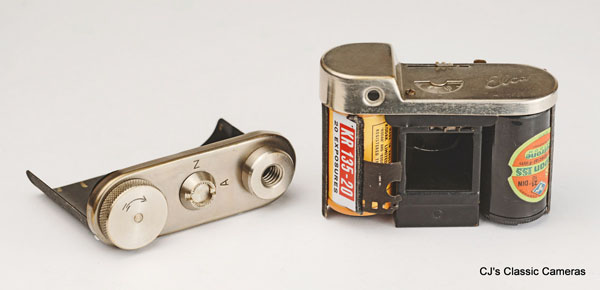
Rear view of the Elop Elca with the back removed and film cassettes loaded. Note the windknob located on the bottom plate of the camera.
The Elop Elca II the follow-up model of the original Elca (see above) and was introduced in 1949 by Electro Optik GmbH from Flensburg, Germany. Unfortunately, the company went bankrupt around 1950, but was restarted as UCA Vereinigte Optische Werke in 1951. It continued producing the Elca II, which was renamed the Ucanett. The company also produced a reflex camera with focal plane shutter, the Uniflex (later renamed to Ucaflex), which was in fact largely based on the Neucaflex first developed during Neubert's Jena days (see Elca above). In 1952 the company was taken over by Agfa.
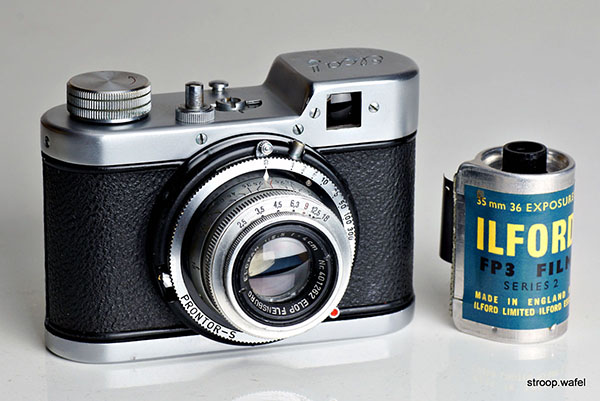
A 1949 Elop Elca II with a 4-element Elop Flensburg Elopan 40mm f/2.5 lens in Prontor-S shutter. The lens was mounted as a single unit in front of the shutter. Note the little collar around the shutter release button which can be removed to reveal a Leica-style remote shutter release.
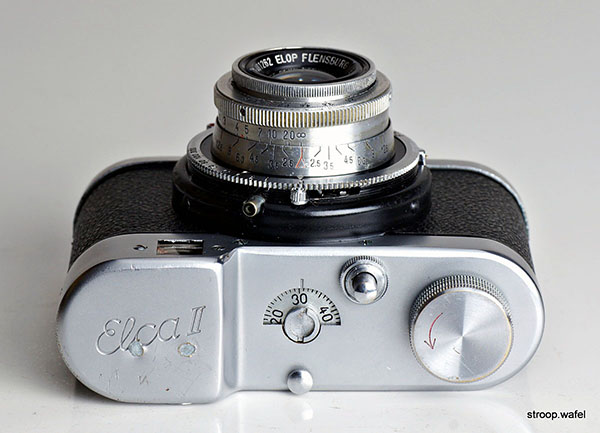
Top view of the Elop Elca II. Two small holes in the top housing are due to an aftermarket accessory shoe being mounted and subsequently removed. All in all a well-featured little camera with fast f/2.5 lens, unit focussing, body-mounted shutter release, double exposure prevention and flash sync, all in a very small package.
The Elca II was available with either of two lenses, a 35mm f/4.5 Elocar and a 40mm f/2.5 Elopan (the latter renamed Ucapan on the Ucanett). It usually came with a Prontor-S shutter although it could also be found with a Vario shutter. Late production had a accessory shoe mounted behind the frame counter, like on the later Ucanett. Part of the earlier production, including the example shown below, had a peculiar little button behind the frame counter (and no accessory shoe) of which the function is unclear to me, it did not move and had no function for the wind mechanism.
A final peculiarity about the Elca II was that, like its predecessor, it had no rewind knob, yet took regular 35mm film. Hence, one needed a 35mm uptake cassette to use the camera. It did have a sprocket wheel so the film frames were spread evenly. Based on serial numbers of the lenses, about 6000 units of the Elca II were produced (including Ucanett).
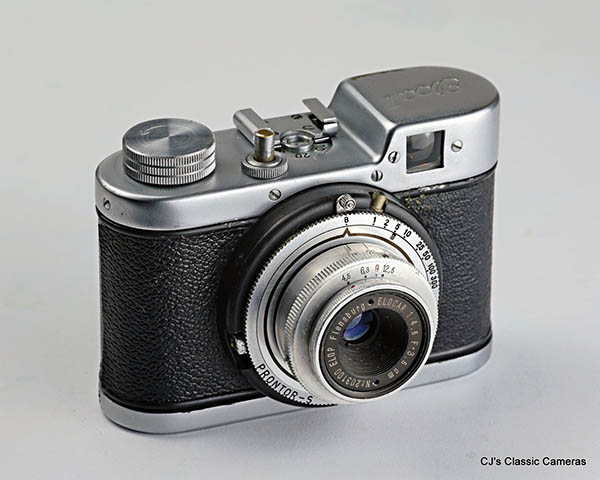
A slightly different variant of the Elop Elca II with a accessory shoe. This also has a different lens, an Elocar 35 mm f/4.5.
Schwarzbauer Arex
The Schwarzbauer Arex was one of only few 35mm cameras to be made in Austria. It was designed and build by Joseph Schwarzbauer, who obtained a patent for it. It was quite a simple camera but nevertheless had all the features typical of cameras at the time, including a with a three-speed flash-synchronised shutter, double exposure prevention, adjustable focus and aperture as well as an accessory shoe. The removable back simply clamped onto the body. The camera did not have a take-up spool or rewind mechanism so needed to be used with a take-up cassette instead. It had a frame counter on top, the central button of which needed to be pushed after each exposure to reset the double-exposure prevention mechanism. The lens was actually removable and was almost identical in construction to the Finetta lenses, including the unusual 43mm focal length. However, it had had a different diameter screw mount, and it does not appear any other lenses were made for the Arex. The rotary was also quite similar to the Finette shutter.
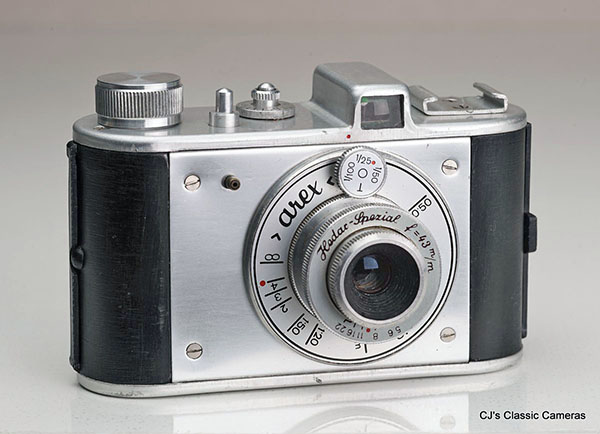
An early Schwarzbauer Arex with Hedar-Spezial 43mm f/5.6 lens.
The camera was only build for a few years but some small changes were made during production. The black plastic body cover was plain at first but was later replaced by a textured version. In addition, the rewind knob changed shape and received an engraved arrow showing the wind direction. Finally, early production had a solid shutter release button, soon to be replaced with one with a screw thread for a remote release.
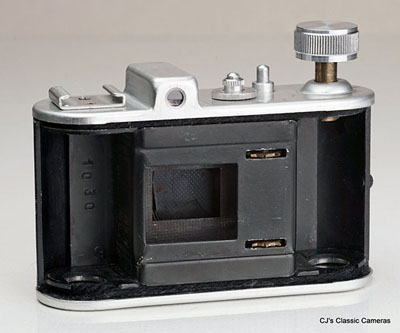 |
It appears the Arex was essentially a one-person home-build camera, but total production was a couple of thousand (based on body serial#) , which is hard to image by one person in only a couple of years of production.
Rear view of the Arex with the back removed. Note the lack of a wind spool, so an uptake cassette had to be used. The rotary shutter is just about visible through the film frame. The serial# is 1030, so I am guessing this was probably the 30th Arex build.
|
Wenk Wenka II
This camera with the in English somewhat unfortunate name Wenka was the only camera build by the Wenk brothers from Nurnberg, the same city that was also home to the Bolta/Photavit factory. It was quite an unusual camera, as it had neither a leaf shutter or a focal plane shutter, instead it had a behind-the-lens two-curtain shutter. In other words, it was essentially a moving slit, like focal plane shutters, but located closer to the lens, and therefore it could be smaller. The company received a patent on this construction. Shutter speeds could be adjusted by a rotating wheel with a top speed of 1/800s and a slowest speed of 1/25. Shutter speeds were seemless, i.e., one could select intermediate speeds if wanted. Another unusual feature was the frame size, which was 24x30mm instead of the more common 24x36mm, although at the time frame size was not yet standardised, i.e., the Minolta-35 and Nikon-M also had frame sizes narrower than 36mm.
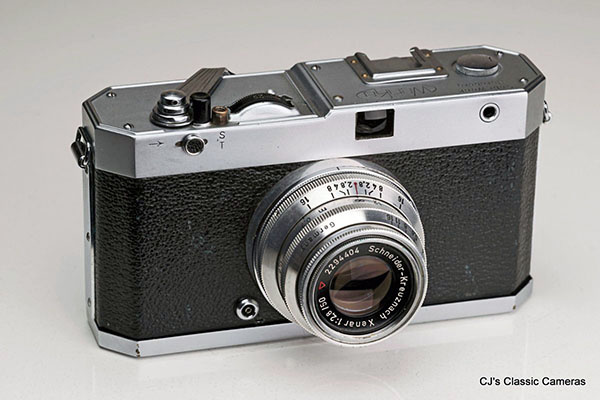
A Wenk Wenka II with interchangeable Schneider Xenar 50mm f/2.8 lens.
The Wenk brothers certainly were innovative, as the interesting features didn't stop there. The Wenka was one of the first cameras to feature a a wind lever instead of a wind knob, and also had a frame counter which would reset automatically, but not when opening the back door, as common on much later cameras, but by pulling up the rewind knob. Finally, the rangefinder had a double mirror system, so the eye piece was located right in-between the range and viewfinder windows. Apparently on the first Wenkas the rangefinder covered the same image as the viewfinder, however on the Wenka II the rangefinder view was reduced to the more familiar central smaller spot. Although I can see the benefit of being able to focus on any spot in the viewfinder image, which undoubtedly was the thought behind this construction, I imagine it can also be distracting and difficult to see the focal point.
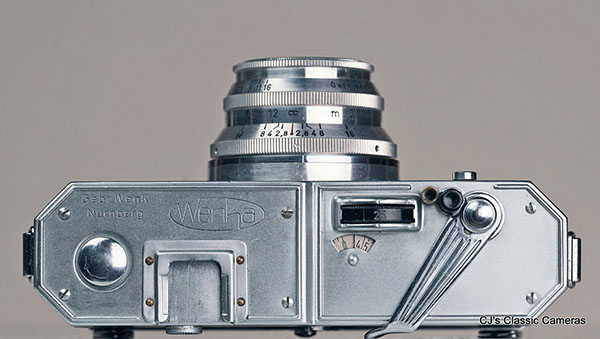
Top view of the Wenk Wenka II showing the shutter speed selector dial just above the frame counter.
The camera also had an interchangable lens mount with a 40mm screw mount, like the KW Praktiflex SLR but with a different flange distance. Other lenses available in addition to the standard Schneider Xenar 50mm lens (suprisingly long considerng the small frame size) were the nowadays exceedingly rare ISCO Westar 36mm and 100mm lenses, both with a f4.5 aperture. Rangefinder coupling simply worked by the back of the unit-focussing lens pushing against a metal plate, which in turn pushed a lever connnected to the rangefinder mirror. This may have caused issues with the wide and telelenses, as they would have shorter and longer focus movements, respectively, unless they had a different focus helicoid design.
Several small changes were made during production. The Wenka I had square view and rangefinder windows, whereas the Wenka II had a small round rangefinder window. Later production had a X-M flash synchronisation selector button below the lens mount and a top shutter speed of 1/500 instead of 1/800. It is unclear if the shutter was actually different or that 1/500 was simply a more realistic value indicated on the shutter speed dial.
Very little can be found out about the Wenk brother, why they started making cameras, and what happened with them after their short adventure. It appears they ran an opticians around WWII, and afterwards they made medical equipment.
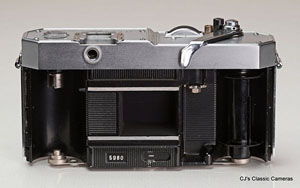
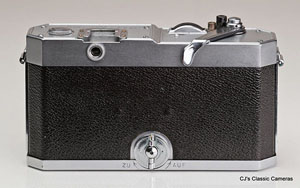
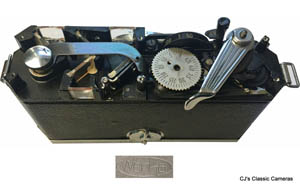
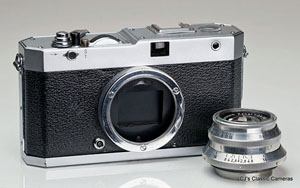
Several more views of the Wenka II. Bottom right is with the top cover removed and the wind lever remounted. Note the multiple mirrors of the view/rangefinder system. The long lever extending from the rewind knob to the frame counter initiates the frame counter reset when the wind knob is oulled out.
Birnbaum Super Perforetta
Even though Germany was the main camera maker in-between WWI and WWII, many other countries did have modest camera industries and Czechoslovakia was no exception. The most well-known company was probably Meopta (see Flexaret), and one of smaller camera makers was Birnbaum. This company appears to have mostly produced rebranded cameras, such as the Embirella, a copy of the Balda Piccochic, and several Filmax models, which were various other Balda copies. Often these featured Birnbaum-branded lenses such as Doxar or Doxanar. However, the company did make a few cameras of their own, including the Birnbaum Perforetta and Super Perforetta.
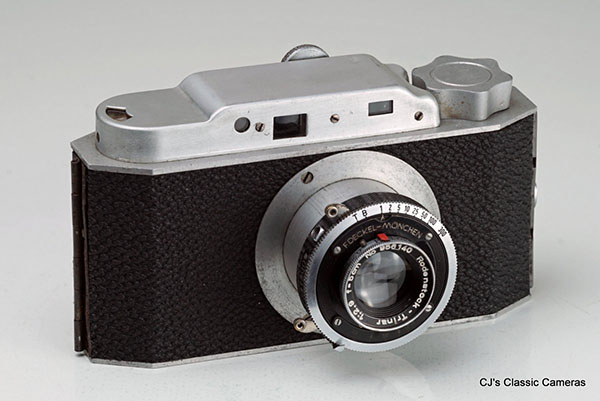
A Birnbaum Super Perforetta with Rodenstock-Trinar 50mm f/2.9 lens in Compur shutter, which seems a surprisingly well-specified lens-shutter combination for a rather low quality camera body.
The Perforetta and Super Perforetta were quite similar: both were 35mm cameras with a collapsible lens, an uncoupled rangefinder with a separate viewfinder and lacking a rewind knob so needed to be used with a film uptake cassette. The difference was in the body construction, the Perforetta the top and inner body needed to be pulled out of the main body to load film, whereas the Super Perforetta had a more standard back door. The cameras were made from quite cheap materials and give the distinct impression of having been fabricated on somebody's home bench.
These were in stark contrast with some other cameras the company made, the Doxa, which were beautifully crafted 35mm viewfinder cameras, again with collapsible lenses. Quite a few different varieties exist but all are very rare, so perhaps these were special orders? It would be interesting to hear from anyone who knows.
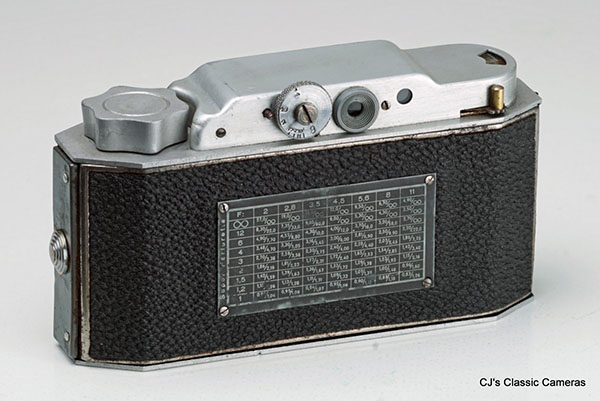
Rear view of the Birnbaum Super Perforetta showing the uncoupled rangefinder dial. Note the distinctive, large scalloped wind knob, which makes it easy to distinguish from the regular Perforetta, which had a round wind knob. The small brass lever to the right is to reset the wind lock after firing the shutter and also advances the frame counter.
Goldammer Golda
Goldammer was a relatively unknown camera maker from Frankfurt, and precious little information can be found about the company or its founder. Its main success was the production of a range of 6x6 rollfilm cameras with collapsible lenses, including the Goldeck and GuGo. However, the first camera by this company appears to have been the Goldammer Golda, which was introduced around 1948. It was a 35mm camera of rather simple construction with an uncoupled rangefinder, the focus dial for which was integrated with the wind knob. The most peculiar feature was probably the shutter release mechanism, as pushing the body-mounted shutter release would result in the whole barrel around the lens base being turned to trigger the shutter.
A version with coupled rangefinder was also available. On this model a focus lever was integrated in the lens based (similar to the Iloca II and early Photavits). The dial beneath the wind knob was used as a depth of focus indicator. Most Goldammer Goldas had a round rangefinder window and a rectangular viewfinder window, but very early examples had two rectangular windows. Considering its current rarity, the Golda probably was not a great success.
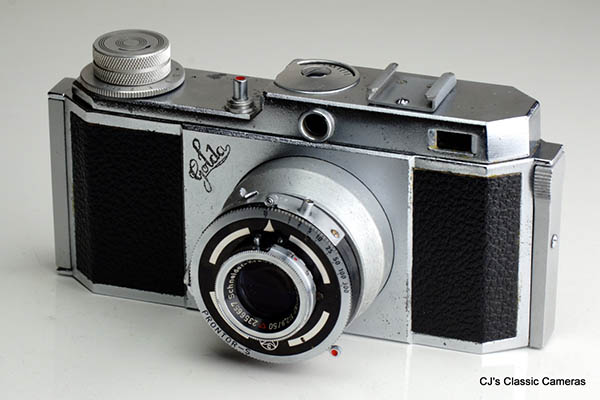
A 1950 Goldammer Golda with Schneider Radionar 50mm f/2.9 lens in Prontor-S shutter. All examples I have seen have a rather poor matt chrome (?) finish which easily corroded.
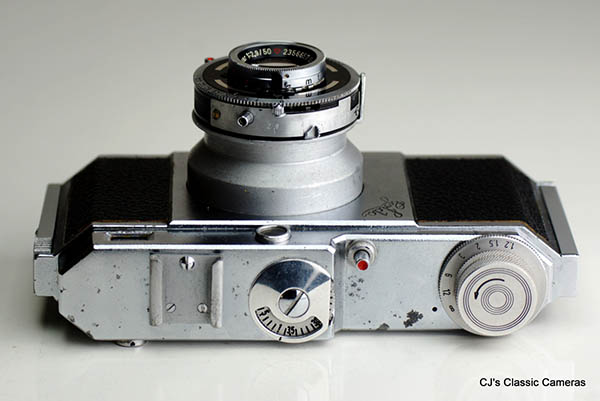
Top view of the Goldammer Golda. The rangefinder adjustment wheel is integrated with the wind knob. Note the lack of a rewind mechanism! The camera needed an uptake cassette to work. On the inside it also lacks a wind spool.
Goldammer Goldix 4x4
The Goldammer Goldix 4x4 was a rather simple rollfilm camera for 4x4 cm format on 127 film, not unlike the Leidolf Leidox or the Bencini Relex. For its time (ca. 1950) it was a pretty modern looking camera so you'd be forgiven for thinking it was an instamatic camera, but these weren't introduced until a decade later. The Goldix was pretty much a point and shoot camera: it had a fixed focus lens and a shutter with two speeds and two aperture settings, f/7.7 and f/11. The two aperture settings had symbols for cloudy and sunny weather, respectively, but it wasn't indicated which shutter speed to use with these. All in all a cheap and cheerful camera, ideal to take on your holiday.
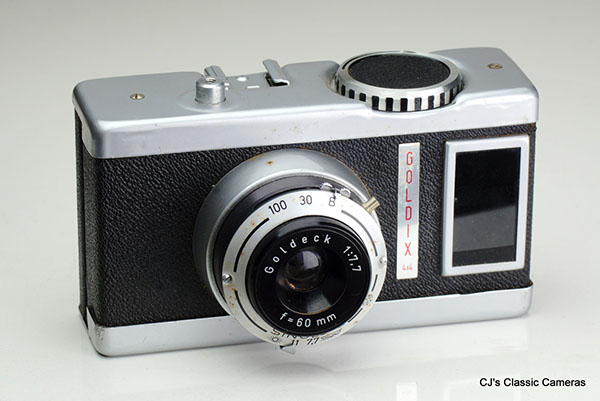
A Goldammer Goldix 4x4 with Goldeck 60mm f/7.7 lens in Singlo-2 shutter. As this was a square format camera it could be held vertical as well as horizontal, personally I'd say that vertical feels a little more comfortable. The large rectangular glass section right of the lens contained a square viewfinder. Perhaps Goldammer planned to produce a 6x4 version?
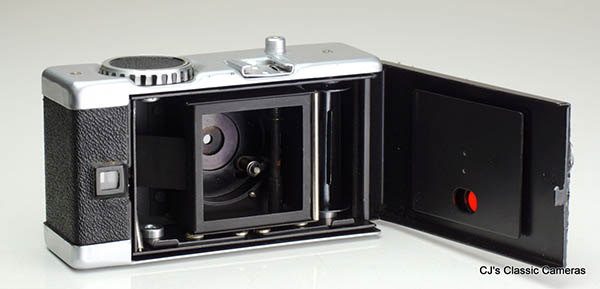
Rear view of a Goldammer Goldix 4x4 showing the film compartment.
Like Birnbaum above, Eta was a small camera maker from Prague in Czechoslovakia. The Eta Etareta was a rather utilitarian looking 35mm viewfinder camera made of solid aluminium with bold knobs and edges, and featured a collapsible lens mount but not much else. It appears the Etareta was in fact the only camera the company ever made, although a slightly different variant with accessory shoe exists. Later production had black leather inlays in the wind knobs, and even later the camera appeared with Compur and Prontor II shutters, which suggests they were built before or during WWII, but available documentation indicates the cameras were made from 1947 to 1948. I've also seen some versions with teal, green or blue leather, which went well with the shiny polished aluminium. Based on the serial numbers that are printed prominently at the front of the camera, at least about 46,000 were built, assuming they were all numbered consecutively. In 1948 the company was taken over by Meopta.
Interestingly, these is still a Czech company called Eta which makes household equipment and claims to be founded in 1943. However, it started its life as Esa and only in 1960 did it register the name Eta. The Eta logo looks very similar to the one on the Etareta, but was only introduced in 2008. Strange coincidence?
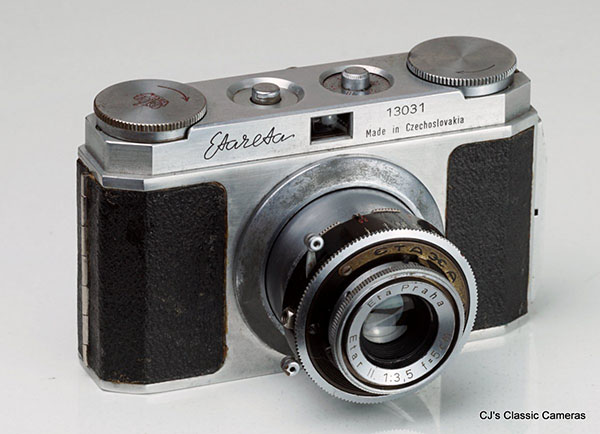
A Eta Etareta with Etar II 50mm f/3.5 lens in Etaxa shutter. Note the two buttons on the top; the right one is from the frame counter, the one on the left was used to reset the wind lock after firing the shutter.
Foitzik Foinix
Foitzik was a small cameramaker from Trier, former West Germany that made several camera models from 1950 till 1958. Its main effort were several relatively simple 6x6 folding cameras, in addition it produced a 35mm camera, which was the Foinix. It was simple viewfinder camera with front-cell focussing triplet lens, and a little reminiscent of the Braun Gloriette. There were two different versions, one with a 'Foinix' marked Vero or Pronto shutter and another with Prontor-SVS. The lens was a Trier AR Foinar 45mm f/3.5 or f/2.8, which appears to have been made by Foitzik itself. Early production had a wind knob with lever, like on the King Regula IP, later production had a single wind lever.
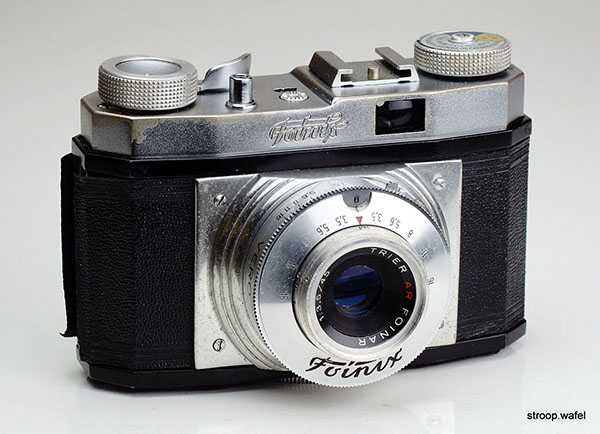
A Foitzik Foinix with Trier AR Foinar 45mm f/3.5 lens in Vero shutter.
Dr. Wöhler Favor I & II
The Favor is a fairly rare 35mm camera built by Dr. Wöhler in Saar, now Germany. It had a rather unique body shape dominated by the metal top housing with a large integrated viewfinder. The Favor was introduced in 1949 in France, as Saar was administrated by France until 1957 when it re-united with Germany. Dr. Wöhler, Optische Fabrik, Saarbrücken was an optical factory that made microscopes, binoculars, filter and lenses. There is some mention on the internet that the company also assembled the Leica IIIs marked 'Monté en Sarré', but it appears that this was actually done by Saroptico, St Ingbert, so a different company.
There are several different models, although sources on the internet differ somewhat in opinion. Based on avalaible images, I think it can be summarised as follows:
The first model, the Favor, was in introduced in 1948 or 1949 and had no accessory shoe. It was initially marked as Dr. Wöhler, Kassel, not Saar, and had mushroom-shaped wind knobs. Very early production had the body number stamped on the viewfinder. The lens was a Rodenstock Trinar or Dr. Wohler Citar f/3.5, later replaced by a Dr. Wohler Docar f/2.8.
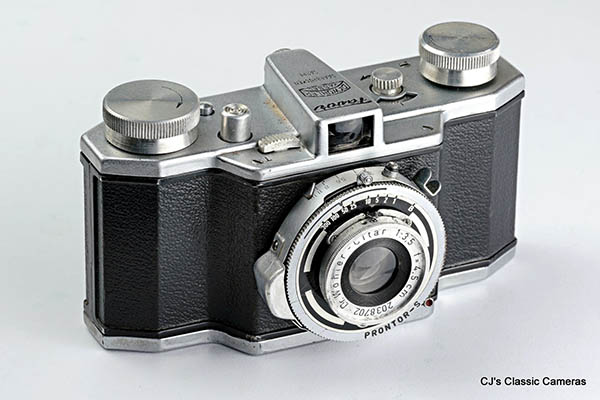
First version of the Favor marked Dr Wöhler Kassel on its viewfinder. It has a Citar lens which based on the serial number is probably a rebranded Rodenstock Trinar lens, which can occsaionally also be found on this early model.
The second model, the Favor I, was introduced in 1950 and is the most common. It had an accessory shoe and large wind knobs. Early versions like the one below (lens # up to ca. 4-900) had a depth of field dial on the back, later ones have a depth of field on the shutter. The lens was a Docar 4.5 cm f/2.8. Initially most had a Prontor-S shutter, but occasionally a Compur-Rapid or Synchro-Compur, later (from lens# ca. 6000) usually a Prontor-SVS.
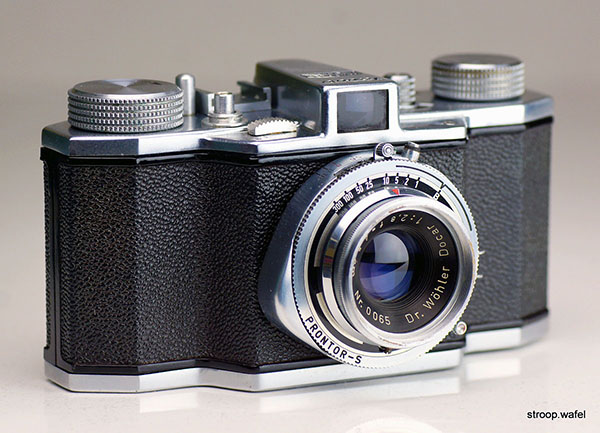
An early Favor I with a very low lens serial # 0065 and body # 9259.
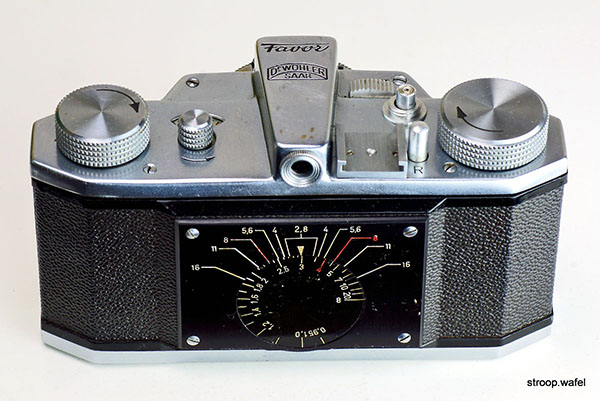
All Favors had a very long viewfinder with the camera's name and manufacturer engraved. The early Favor I featured a prominent depth of field dial on its back.
The third model, the Favor II from 1958, introduced quite a few changes: it had a lever winder, the frame counter was integrated in the wind knob, the accessory shoe moved to the opposite side of the viewfinder and the rewind knob had a film reminder dial. In addition, the name of the lens changed to Color-Docar. The change happened around lens # 10000. Note that the difference between body and lens # for the Favor I and II is about 10000.

Dr Wöhler Favor II with Color-Docar 45 mm f/2.8 lens in Prontor-SVS shutter.
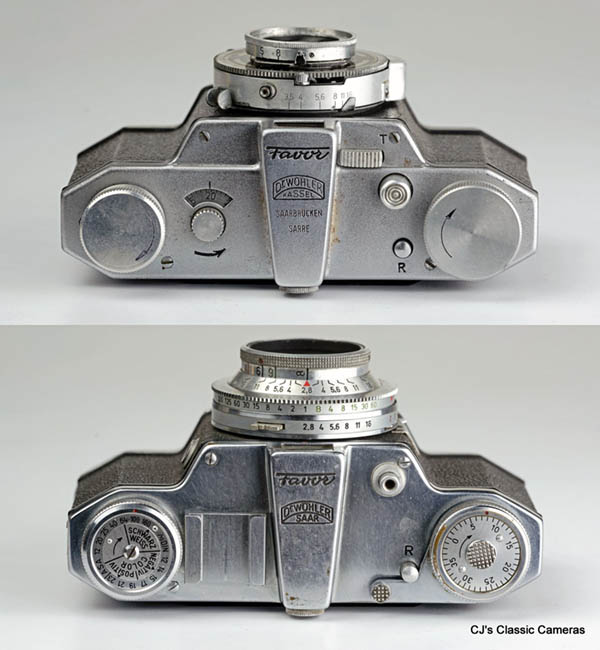
Top view of the first and last Favor models, showing various changes to the camera during its few years of production.
Mimosa I and II
The Mimosa is sometimes referred to as 'the brick' and indeed it is a rather boxy little camera. It certainly was one of the smallest cameras taking 135 film. Mimosa was a company producing photographic paper in Dresden, Germany, but ventured out in the shutter and camera design and manufacturing just after WWII.
The 1948 Mimosa I was dominated by the front-cell focussing lens/shutter assembly and had a tiny fold-up viewfinder with integrated frame counter. It was available with a range of shutters, such as a Vario, Stelo, Prontor II or Compur-Rapid, and also various lenses including Meyer-Optik Trioplan and Ludwig Meritar.

A Mimosa I with Ludwig Meritar lens in self-cocking Stelo shutter.
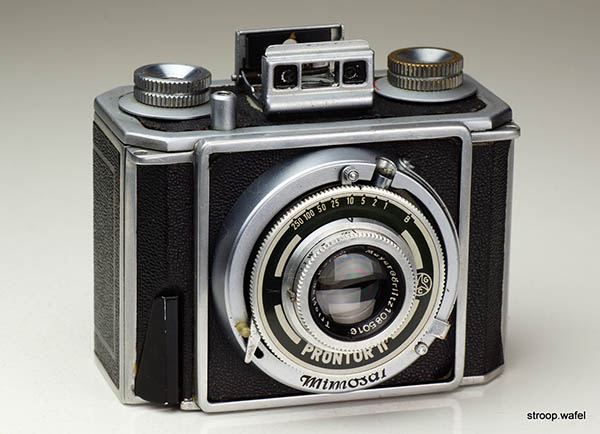
A slightly different Mimosa I with Meyer Trioplan 50mm f/2.9 lens in a Prontor II shutter. There are several cosmetic changes compared to the Mimosa I with Stelo shown earlier, which mainly had to do the shape of the shutter used. For example, the location of the name and the aperture scale are different.
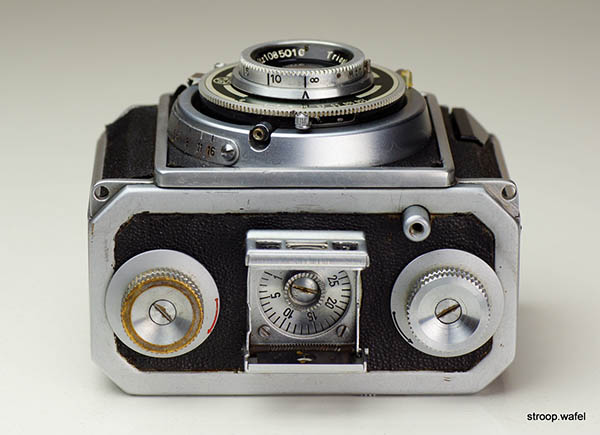
Top view of a Mimosa I. Note the frame counter, which is located in the base of the folding viewfinder.
The 1949 Mimosa II had the viewfinder integrated in the body. For both models the camera back had to be removed to load film, the large lever on the bottom left of the camera functioned as the back release.
For the Mimosa II the shutter was either an in-house produced Velax of the self-cocking type or a Prontor-S shutter which needed to be cocked by hand. A Mimosa II version with helical focus was also produced, recognisable by the little tab on the shutter base opposite from the viewfinder.
The camera and shutter division of Mimosa was bought by Zeiss Ikon in 1950, who apparently continued to produce the camera for a short while.
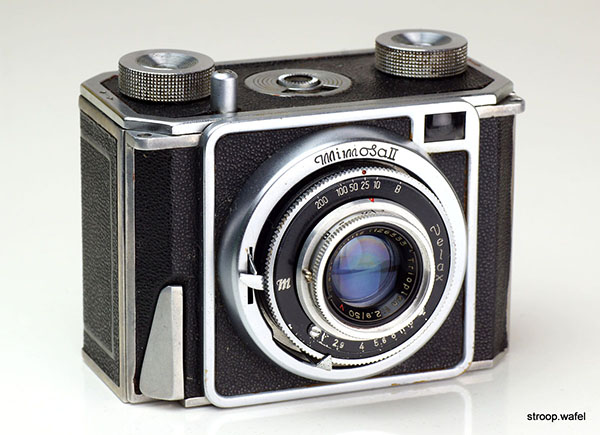
Mimosa II with Meyer Trioplan 50mm f/2.9 lens and Velax shutter. Mine has a quirky shutter that needs assistence by gravity to work: it only cocks when the camera is tilted 90°!
This is the reluctant Velax shutter opened up. The issue is that below the black lever at the bottom, there is another lever that does not get pushed far enough while pushing the shutter release. To reach it the whole shutter needs to be disassembled, a high-risk low-reward situation.
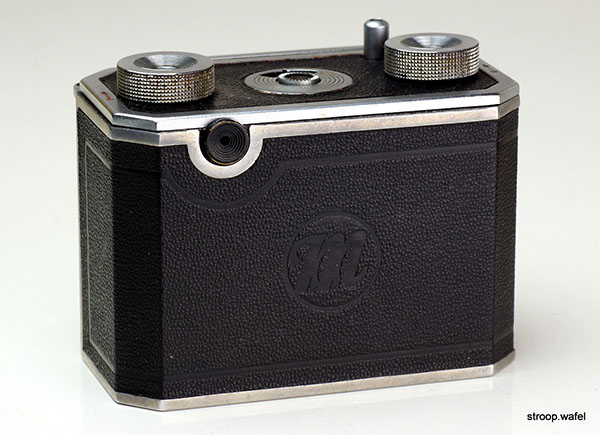
Rear view of a Mimosa II showing the miniscule viewfinder.
Bolsey 35 model B
The Bolsey 35 model B was a quite unique looking camera, which a triangular body with the lens at the base. A little like an Exakta Exa with the lens mounted at the wrong side. It had a viewfinder plus a separate coupled split-image rangefinder with an enlarged view for more accurate focussing. It was a small but solidly built camera that was easy to use, and I'd say rather charming.
Bolsey was a camera maker from New York, U.S.A., but its founder Jacques Bolsky was of Swiss origin. He had started designing cameras in his native Switzerland, including an early Reflex camera which would later be the base of the renowned Alpa cameras, but emigrated to the U.S.A. around WWII. Here he started building high-quality cameras until 1957, when he sold the company to Wittnauer.
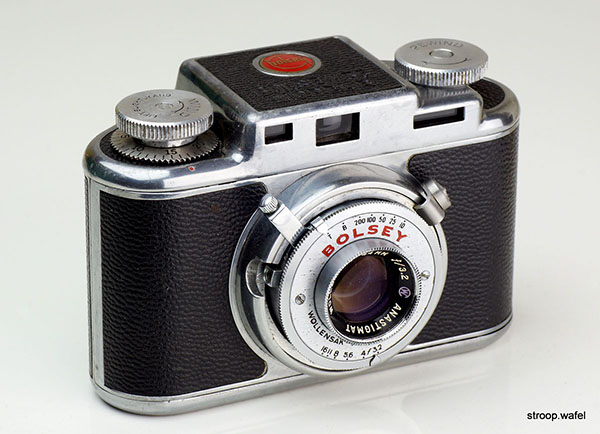
Bolsey 35 model B with Wollensack Anastigmat 44mm f/3.2 lens.
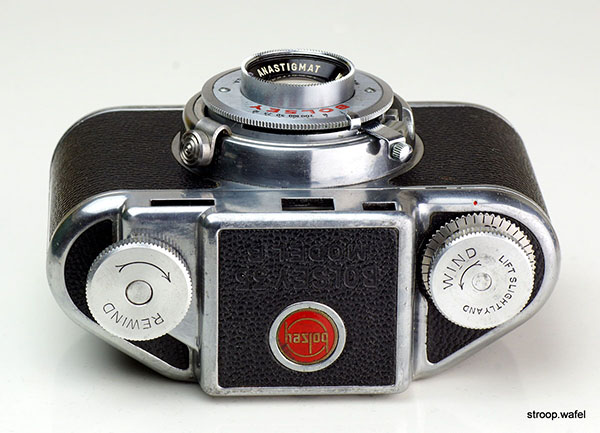
Top view of a Bolsey B showing its unusual body shape.
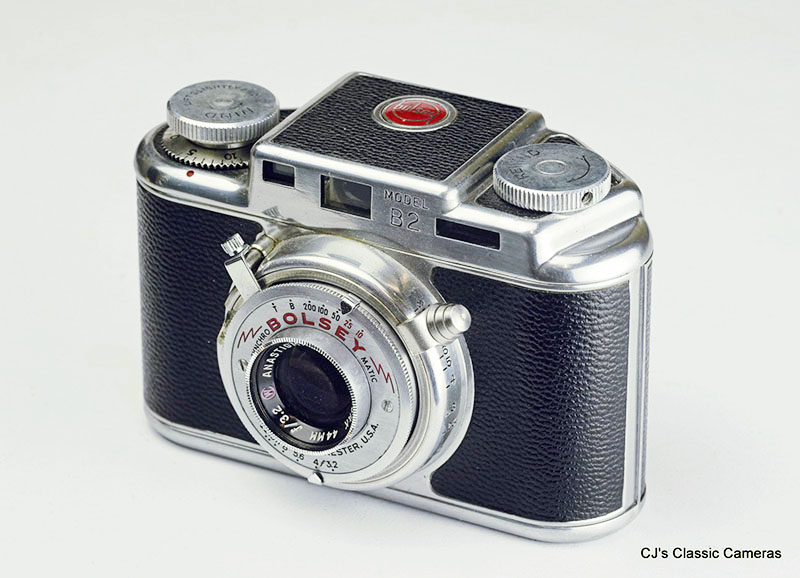
An updated variant of the model B was this model B-2. The main difference appears to be the shutter, which for this model has flash synchronisation and and additional f/22 aperture setting.
Argus A
The Argus A is one of the more important cameras in the history of photography, as it made 35mm photography affordable for most people and became hugely popular. It was first introduced in 1936; it was a simple viewfinder camera with a bakelite body (plastic) and a collapsible fixed focus lens. It sold for only $12.50, which was a bargain at the time. Soon after a similar cameras with focusable lens and/or extinction meter were introduced, the Argus AF, A2 and A2F, respectively. At least half a million were produced in the five years until the US got involved in WWII.
Despite its cheap price and apparent simplicity the camera was well equiped, having a frame counter, adjustable aperture and a good range of shutter speeds. The three-element lens reported performed well also.
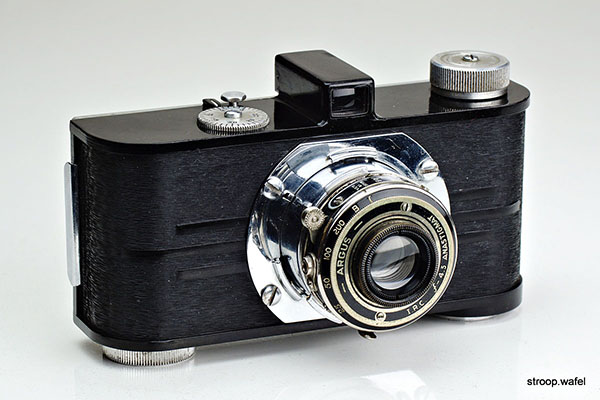
An Argus A with f/4.5 Anastigmat lens. This is one of the later variants made in 1941. The fixed focus lens could be rotated such that it would snap into place at a slightly longer distance from the film frame, this setting should be use for closer-focus pictures (within 6m).
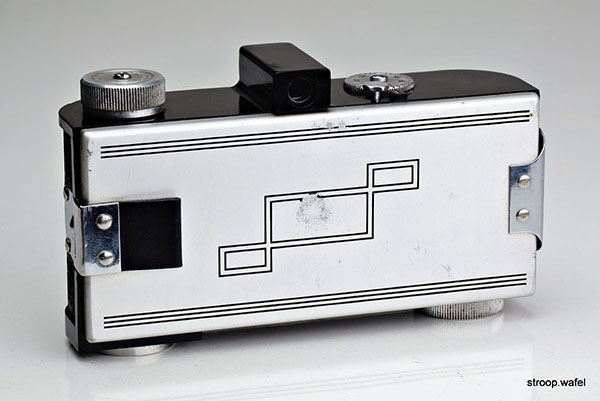
The back of the Argus A was an Art Deco styled metal plate which would come off in its entirety to make the film loading bay easily accessible.
Argus CC
The Argus CC was developed from the Argus A3, which itself was a simple but sleek-looking viewfinder camera with an extinction meter introduced just before WWII. On the CC the extinction meter was replaced with a rather oversized lightmeter unit, which did spoil the smooth lines of the original somewhat. On the back of the camera was an exposure dial which would translate the light values from the lightmeter to aperture and speed settings for the shutter. The camera had a spring-powered collapsible lens mount with helical focus. The shutter was self-cocking and needed to be fired with a lever on the shutter itself, the button next to the viewfinder was only there to reset the wind lock mechanism. The camera had no double-exposure prevention. The frame counter was on the front of the camera next to the lens.
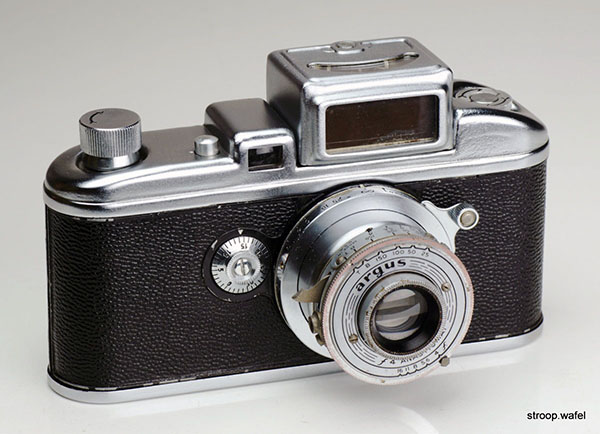
An Argus CC with f/4 Anastigmat lens. Note the large lightmeter.
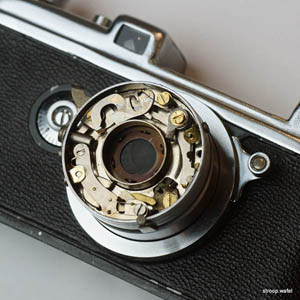
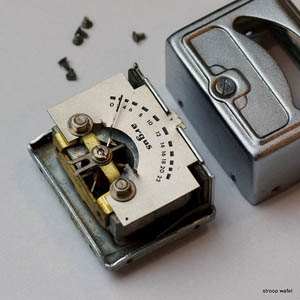
(left) Self-cocking shutter of the Argus CC, it has a speedcam on the bottom left whereas the B and T settings are controlled on the top. These needed lubricating for the shutter to work again. (right) Lightmeter taken out of its shell. It miraculously started to work again after this.
Argus C3 / C3 Matchmatic
The Argus C was introduced around the same time as the Argus CC above but was in many ways its complete opposite. It had none of the CC's sleek design and simplicity, instead it was square, boxy and had complicated looking dials and levers. It was also very heavy, and this, combined with its look, gave it its nickname 'the brick'. Despite this, it is on of the most succesful cameras ever made, with around 2 million being sold, if we include de Argus C2 and C3, which followed soon after the introduction of the Argus C.
The Argus C3 had a coupled split-screen rangefinder, with the lens being connected to the rangefinder by a gear on the front of the camera. The lens was interchangeable but changing the lens required removing the idler gear, which surely was a hassle. The shutter speed was set through a dial on the front and the film was wound with a wind knob at the top, which was located on the opposite side of where it was found on most other cameras from that era.
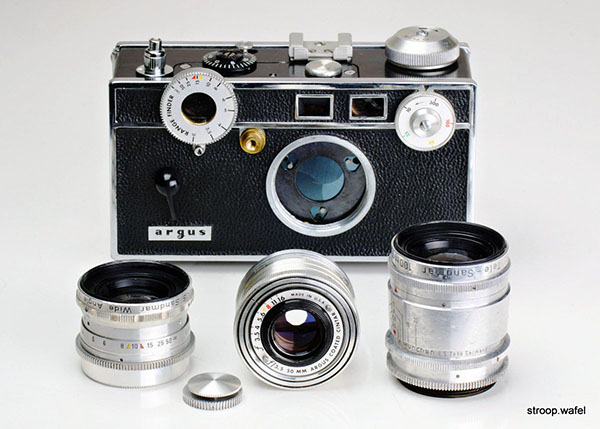
A 1956 Argus C3 outfit with Sandmar Wide Angle 35mm f/4.5, Argus Cintar 50mm f/3.5, and Tele-Sandmar 100mm f/4.5 lenses. The Sandmar lenses were made by Enna-Werk in Germany, although the 'patent pending' mark on the 35mm lens suggests they were made using an Argus design. The lens mount itself was a simple screw mount. Also shown is the small gear that needs to be removed to change lenses.
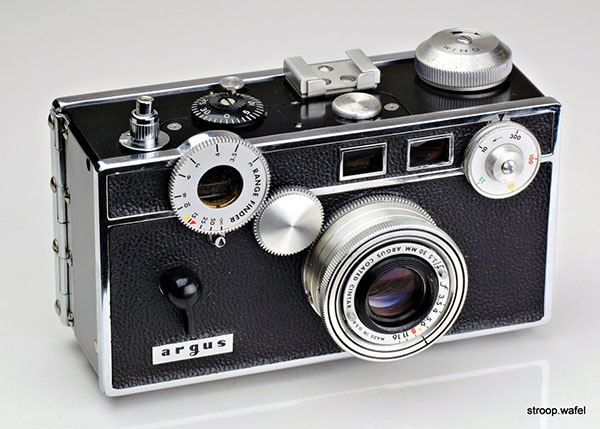
Close up of the Argus C3 with its standard lens mounted. The camera had no bulb setting on the shutter speed dial, one simply had to rotate the base of the shutter button on top of the camera instead. So if your Argus C3 only fires at bulb setting no matter what the setting on the speed dial, check this button first.
The Argus C3 had a very long lifespan as it was produced until 1966. In its last decade a few fancier variants were introduced, including the tan-coloured Matchmatic. Instead of regular shutter speed indicators on the speed dial there were numbers 4-8 which matched the numbers on the lightmeter. The numbers matched the shutter speeds on the regular C3, so 1/10, 1/25, 1/50, 1/100 and 1/300. The Matchmatic received a little fame again quite recently, as it featured in the movie 'Harry Potter and the Chamber of Secrets' as the character Colin Creevey's camera.
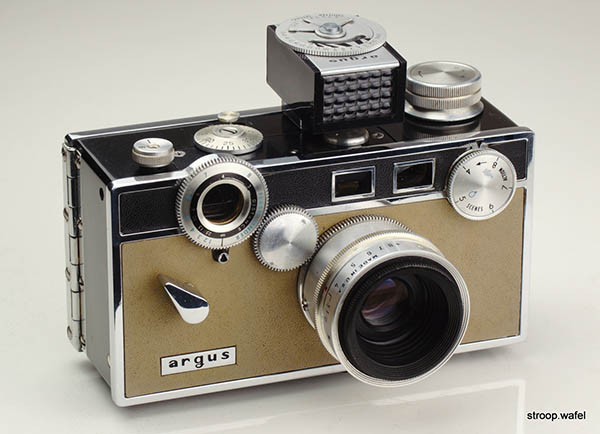
A 1959 Argus C3 Matchmatic with coated Argus Cintar 50mm f/3.5 lens and its lightmeter mounted. Although the Matchmatic was essentially similar to the earlier example above, Argus had clearly kept its designers busy with changing nearly every knob, dial and lever on the camera.
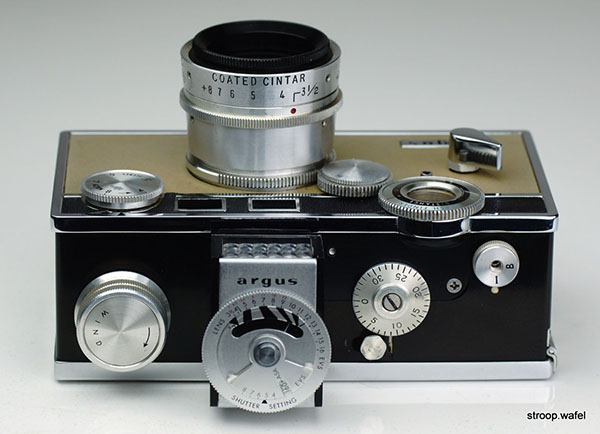
Top view of the Argus C3 Matchmatic. Yes, it is as rectangular and brick-like from the top as from the front.
Perfex Speed Candid
The Perfex Speed Candid was introduced a couple of years after the Argus A by the Candid Camera Corporation in Chicago, USA. It was clearly modelled on the Argus, undoubtedly inspired by its succes, but added a whole range of features. This included an uncoupled rangefinder, an interchangeable lens mount, an extinction meter for exposure measuring, and to top it all off, a focal plane shutter with a top speed 1/500 s. So one could say it was ahead of its time, but unfortunately it didn't work particularly well. It also faced competition from another Argus camera, the Argus C, which had a similar range of features but lacking the focal plane shutter. Thus, this first Perfex camera was not a great commercial success, but it was followed by an improved range of cameras with a funny range of names such as the Twenty Two and the Fourty Four which looked like much more thought had gone into it. Nevertheless, not long after WWII the company decided to close its camera business and sold off their camera designs (see Graflex Ciro 35 below).
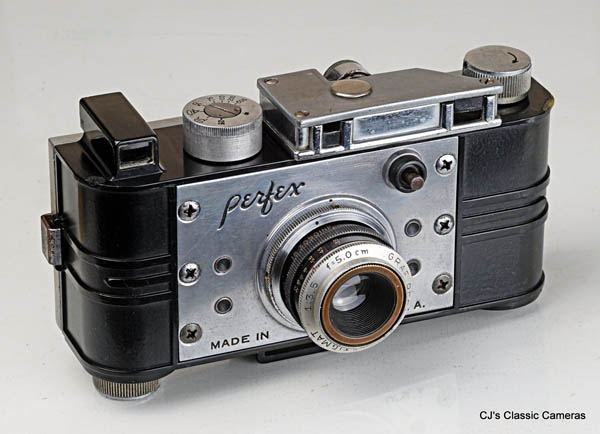
A Perfex Speed Candid with interchangeable Graf Perfex Anastigmat 50mm f/3.5 lens, presumably made by Graflex.
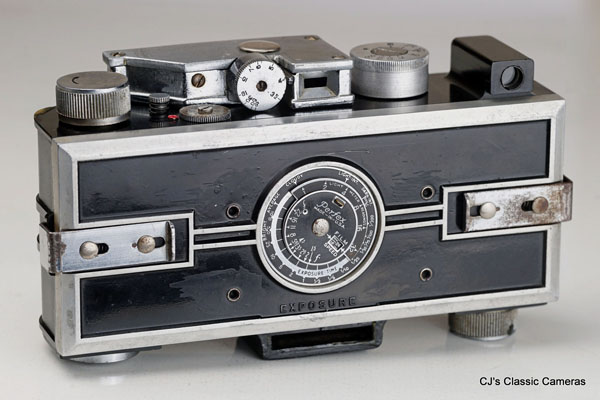
Rear view of the Perfex Speed Candid. It featured a daunting looking exposure calculator to be used with the extinction meter mounted at the bottom of the camera. The extinction meter would show a range of numbers depending on the brightness of the scene one was aiming at. One would look up the exposure setting on the calculator based on the maximum value visible in the extinction meter.
Clarus MS-35
Clarus from Minneapolis, U.S.A., is not a very well known camera maker and in fact the Model MS-35 appears to be the only camera they produced. It was introduced just after WWII and on paper it was quite a formidable camera which featured a coupled rangefinder, a focal plane shutter with a 1/1000 top speed and an interchangeable lens mount. It was a solid, heavy, well-finished albeit somewhat oversized camera. However, it appeared the shutter was notoriously unreliable, which meant that it did not build a very good reputation and production stopped in the early 50s.
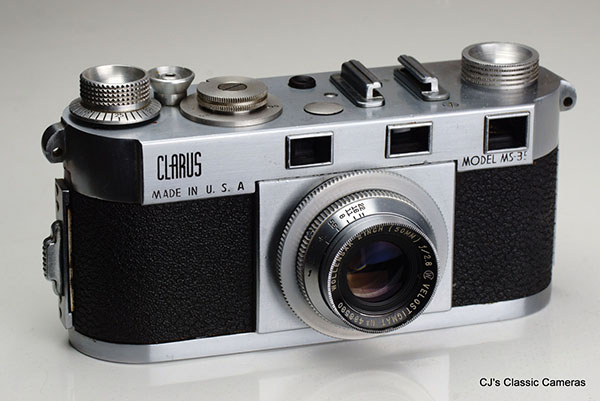
A Clarus M-35 with Wollensack Velostigmat 50mm f/2.8 lens. The cover was a sturdy material called 'redolite', which appears very similar to vulcanite. The lens mount on this example appears different than what is shown in the camera manual. The manual shows the whole lens being removed from the body. However, on this example the base nearest to the body is part of the focussing helicoid. It is possible, however, to remove the lens itself from the helicoid (move mouse over the photo to see the lens removed).
Trusite Girl Scout
The Trusite Camera Company from New York was one of the more obscure camera makers and only a few models are known to be made, most notably the Minicam. This was a very simple 127 roll film point and shoot camera made from aluminium. In fact, it was not dissimilar to the Leidolf Leidox but had a much simpler shutter and a fixed focus lens. A 1947 ad listed the Trusite Minicam with flash unit for $9.95, so it was a cheap camera affordable to nearly anyone.
The Girl Scout was very similar to the Minicam and was perhaps just the same camera branded 'Girl Scout' but lacking the flash sync terminal. This renaming was not unusual, e.g., a Falcon Girl Scout with similar shutter face plate also existed.
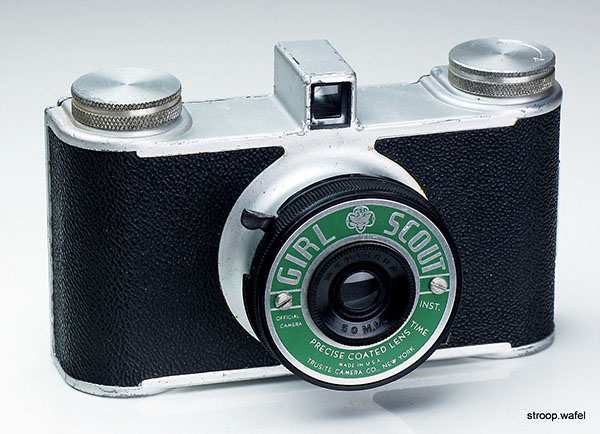
A Trusite Girl Scout point and shoot camera from the late 1940s. The knob on the left serves no purpose and is purely cosmetic.
Graflex Ciro 35
This camera has a somewhat confusing history. It was first developed by Perfex, an American company who just before WWII started making an interesting range of focal-plane shutter cameras with interchangeable lenses such as the Perfex Fourty-Four and Fifty Five. After WWII they went on to make leaf shutter fixed lens cameras, the last one (before the company stopped making cameras) being the Cee-ay 35. The company clearly had a preference for strange camera names! The design of the Cee-ay 35 was bought by Ciro, known for the Ciroflex TLR but not much else. They sold the camera as the Ciro 35. Not long after the camera division of Ciro was bought by Graflex, who kept selling the camera under the same name but also used it as a base for their new Graphic 35.
The Ciro 35 had a coupled split image rangefinder with a separate viewfinder. The leaf-shutter was of the self-cocking type. The camera also featured a hot shoe, one of the earliest cameras to do so. Lenses were made by Wollensack, who also made the lenses for the Bolsey range, but were replaced by Graflex Graftar lenses once Graflex took over Ciro 35 production. I would assume these were rebranded Wollensacks.
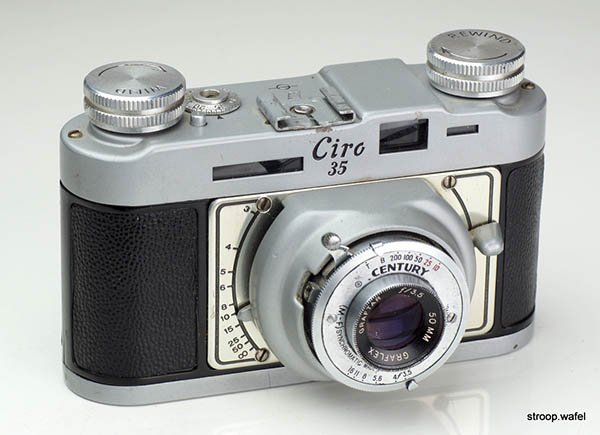
A Graflex Ciro 35 with Graflex Graftar 50mm f/3.5 lens in Century shutter, which was a rebranded Alphax from Wollensack. The camera was made from painted aluminium, which made it very light but it was not the nicest looking finish.
Universal Mercury II
While we're at American cameras we might as well continue with the Universal Mercury II. This was a rather unique camera with a large rotary shutter, which explained the large ridge on top of the camera. The film was forwarded by a knob on the front, the shutter speed knob would rotate during exposure. This was a half frame camera as it was a larger film format was difficult to implement with this particular shutter design without making the camera inconveniently large.
Different shutter speeds were generated by varying the width of the slit in a rotating disc. As the slit width varied continuously whilst rotating the speed knob, one was not limited to the speeds indicated on the knob but one could choose in-between speeds. The shutter was very reliable and the word goes that it was more accurate than curtain-based focal plane shutters on Leica and Contax cameras. However, it was difficult to set fast shutter speeds precisely and reproducibly due to the small difference between the marks at high shutter speeds.
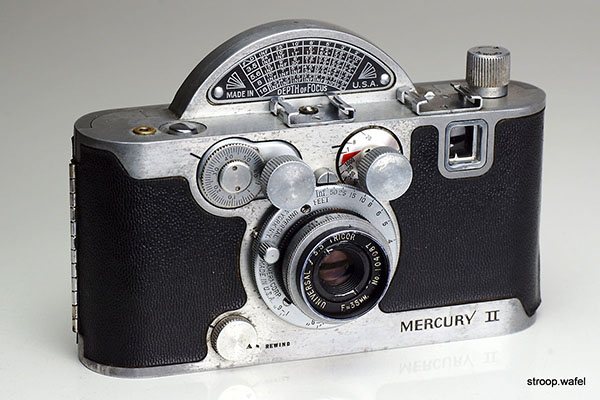
A Universal Mercury II with Tricor 35mm f/3.5 lens. A uniquely styled camera and probably the sort of camera that only a camera collector can love.
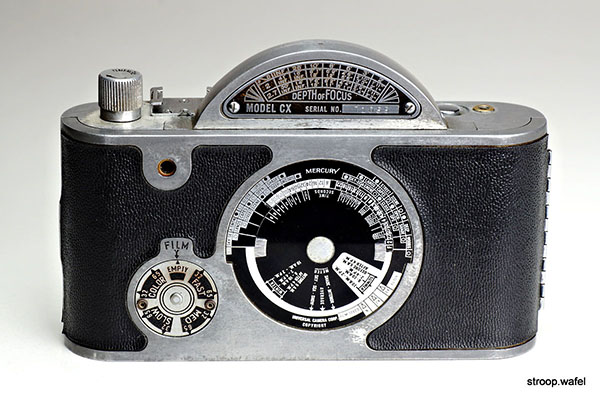
Rear view of a Universal Mercury II showing the rather complicated exposure finder and a film reminder dial. Note the staining of the metal, which is very common for this model, it being made from an aluminium alloy.
A novel feature on this camera was the hot shoe, a very early implementation considering this camera was first built in 1945 and its predecessor the Univex Mercury in 1938 already had this feature. The camera had in fact two accessory shoes, the one in the middle would take the dedicated Universal flash which would be triggered by the contact point in the shoe, the right one could be used for the Universal extinction meter or a rangefinder. Another nifty accessory was the rapid wind lever which could be attached to the wind knob.
The lens on the Mercury II was interchangeable. Other available lenses were a 35mm Tricor f/2.7 and an f/2.0 Hexar. Telelenses were apparently available, but I could not find any record of these.
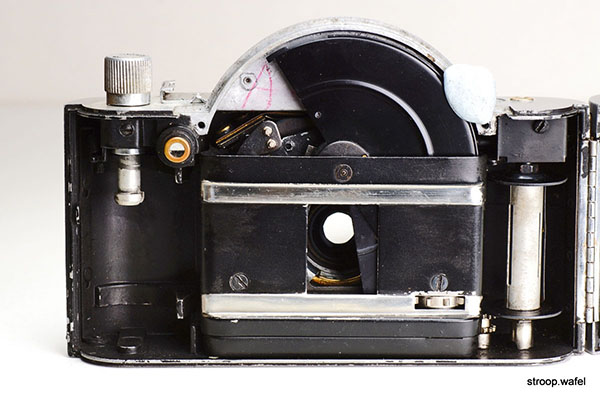
A Universal Mercury II with the back open and part of the top removed to show the rotary shutter. The shutter was set at the T setting but this setting does not work properly on this example, so I stopped it from rotating with a blob of Blu Tack with the shutter partially covering the film gate.
The shutter was constructed from two half disks, one of which was operated with the speed knob so it could be rotated to set the slit size. Here the two disks almost completely overlap and the speed would be about 1/20s. At 1/1000s only a gap of about 2mm would remain. Note that exposure of the top right corner of the frame starts and finishes before the bottom left corner of the frame, unlike with curtain-based focal plane shutters.
Univex Iris
The 1938 Univex Iris 'Candid Camera' was a camera comparable to the Argus A but cast in metal and using Univex '00' rollfilm, which was slightly smaller than 35mm film. It came in two different versions, the Standard with fixed focus lens (shown below), and the Deluxe with leather cover and chrome top housing. An upgraded model with a body-mounted shutter release and hot shoe was sold as the 'Zenith'. The camera had a short production run, as WWII soon caused problems with availability of film made by their Belgian supplier Geveart, making the camera sadly obsolete.
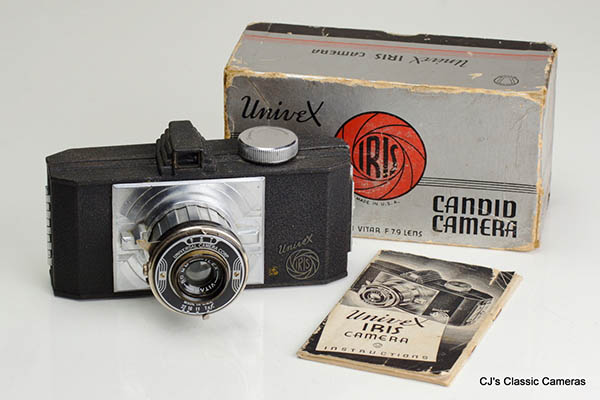
A Univex Iris with fixed focus Ilex Vitar 50mm f/7.7 lens, shown with its original box and instructions for use. Note how the wind knob was located quite far from the edge of the camera, this was because to the side of it there was space for a spare film, which was not a luxury considering that the Univex '00' film only fitted 6 exposures to a roll.
Adox 300
The 1956 Adox 300 was a deviation from Adox's fairly non-distinctive camera line-up, as it had a rather unique feature: it used interchangeable film magazines so one could swap film type or speed whenever needed. The film magazines had a frame counter as well as reminder dials for film speed and type, these were visible through windows on the camera top and back, respectively. A metal blanking sheet would be inserted if one rotate the turning key at the bottom of the camera which was also used to open the camera back, this would avoid exposure of the film when taking it out of the camera. The camera also featured a fairly unusual film wind mechanism: instead of the more common wind lever it featured a push-down lever at the front of the camera (like e.g., the Zeis Tenax and Agilux Agimatic). It was also equipped with an uncoupled Bewi automat lightmeter, which worked by simply pushing a button at the back, after which a dial in the lightmeter would spin and stop at the right exposure value. This lightmeter was also fairly uncommon, but could also be found on the Photavit 36L. The Adox 300 was available with Steinheil Cassar or Schneider Xenar in Compur-Rapid or Synchro-Compur shutter. Its main drawbacks were its large size (due to the film magazines) and the lack of a rangefinder, so it wasn't a great success although serial numbers suggest that close to 10,000 may still have been made.
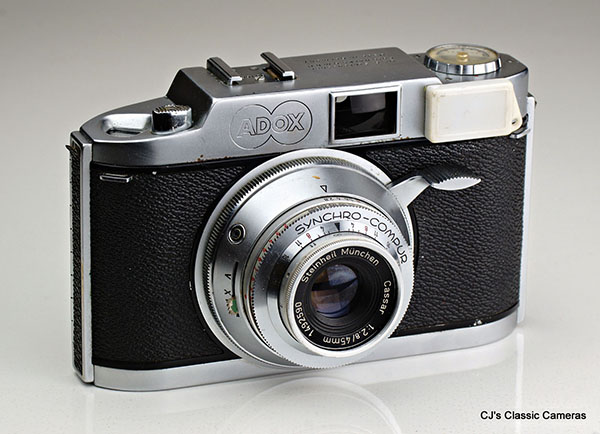
An Adox 300 with Steinheil Cassar 45mm f/2.8 lens in Synchro-Compur shutter. This is an early production example with serial number in the accessory shoe, later models had this number engraved at the bottom of the rear door. Even later production had 'ADOX Fotowerke' instead of 'Dr.C Schleussner Fotowerke' engraved on top.
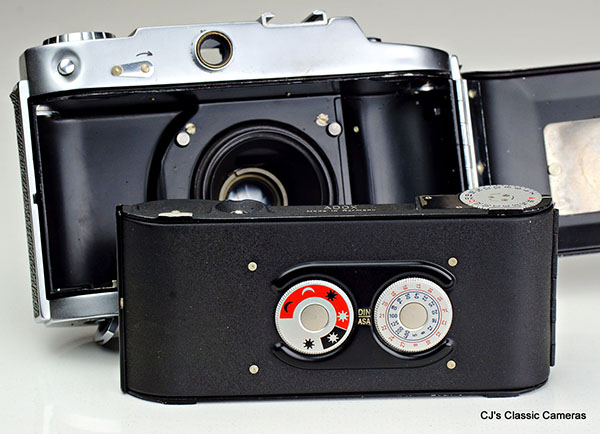
Rear view of Adox 300 showing the film cartridge with frame counter (top right) and film reminder dials (front). On the camera body note the small lever left of the eyepiece, which was for making double exposures: push it up and a little pin inside the camera disengages the film transport in the cartridge when cocking the shutter.
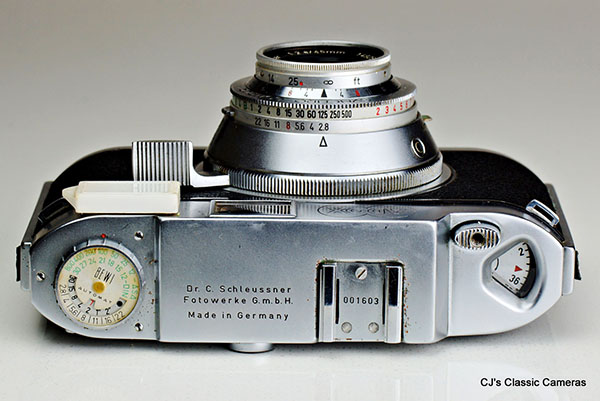
Top view of Adox 300 showing the Bewi automat lightmeter and the window through which the frame counter on the film cartridge was shown.
Adox Polomat
The 1963 (?) Adox Polomat was a rather lightweight but reasonably well-specified camera somewhat akin to the later Retinettes. It had a rapid winder, coupled light meter and bright line viewfinder with a Schneider Radionar 45mm f/2.8 front-cell focusing lens in a Pronto LK500 shutter. Later Polomat models has the light meter needle projected in the viewfinder.
As I mentioned in the section about Wirgin cameras, Adox took over the Wirgin factories after the Wirgin brothers fled Germany just before WWII. After the war Adox continued building its own cameras, including a range of folding cameras, the Adox Golf, and the Adox 300, a unique 35mm camera with interchangeable back.
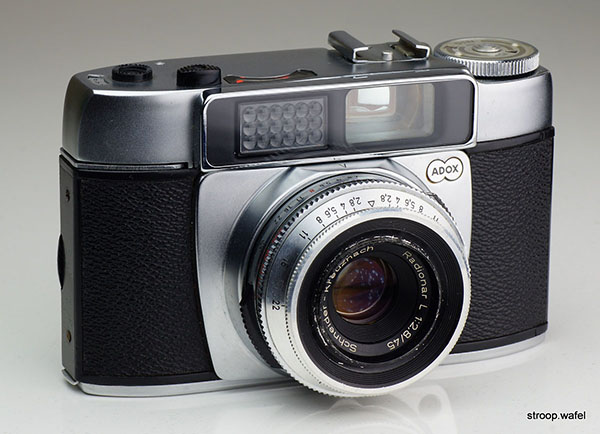
An Adox Polomat with Schneider Radionar L 45mm f/2.8. It is said that the L stands for Lanthanum, a heavy rare earth element using to increase the refractive index of the lens glass. I've only found the marking 'L' on Adox cameras.
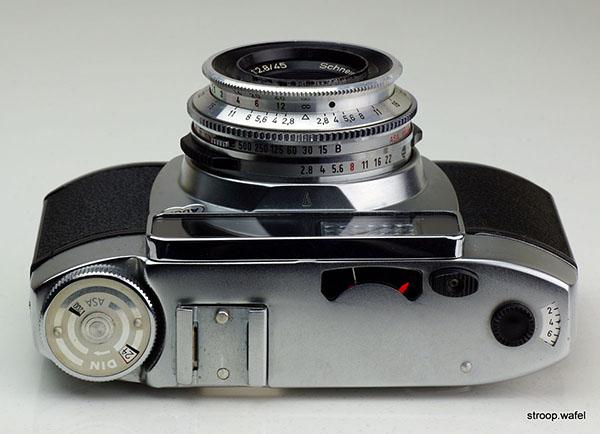
Top view of Adox Polomat showing the coupled light meter window.
Royer Savoya
Royer was a small French post-WWII camera maker that made some interesting cameras, including the beautiful 6x9 Altessa with telescopic lens, the leaf shutter SLR Savoyflex, and the Savoy, of which a variant is shown here. The Savoy range looks like a regular 35mm viewfinder camera that were popular at the time, but it came with a twist: it had a removable front for loading film. Apparently the idea behind it was that one could load the camera whilst keeping it in its case. It wasn't an idea that caught on very well, so Royer first added a hinged back so one could load film the regular way, and abandoned the removable front completely not long after. Perhaps the idea could have had some merit if interchangeable lens fronts had been offered, but I don't think this was ever on the cards.
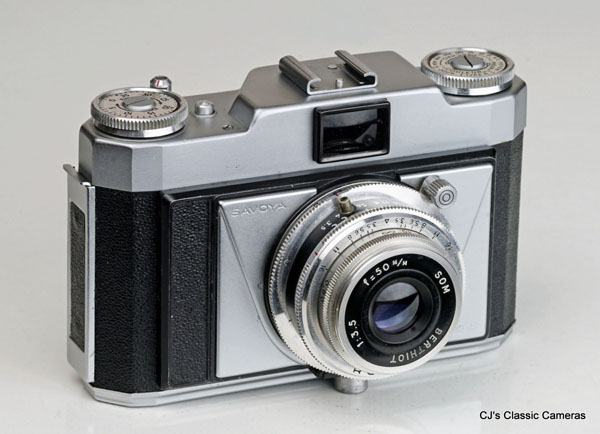
| |
A Royer Savoya with Som Berthiot 50mm f/3.5 lens in what appears to be a shutter made by Royer itself. |
By the way, I always thought Royer was a Swiss brand, as the logo on the camera strongly resembles a Swiss flag (not present on the Savoya above though), but looking into the camera history a bit more after buying this camera, I realised I was mistaken.
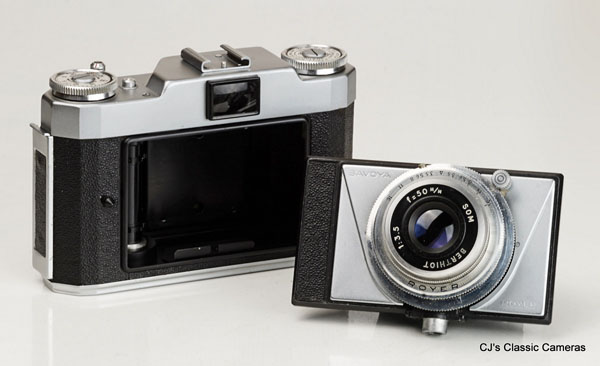
The Savoya with its front removed, showing the large gap in the front of the camera body through which one was supposed to load film. I haven't tried it out, but it just doesn't seem very practical.
Bilora Radix
Bilora was a manufacturer of photographic items founded in 1909 near Wuppertal in Germany. For several decades in the middle of last century, the company also made cameras, often in unusual designs. The company still exists today, but it no longer makes cameras.
The Bilora Radix was, for Bilora's standards, a fairly standard looking camera, but it had some unusual features. It used Rapid cassettes, first introduced by Agfa for their Karat range, which used regular perforated 35mm film stock but loaded and taken up into dedicated cassettes. This avoided having to rewind the film. Whereas the Agfa Karat had a standard 36x24 mm film frame, the Radix had a square 24x24 mm format. The Radix also had unusual sliding film transport lever and shutter release, and the aperture and speed setting controls (if present, not all models had these) were also a little different.
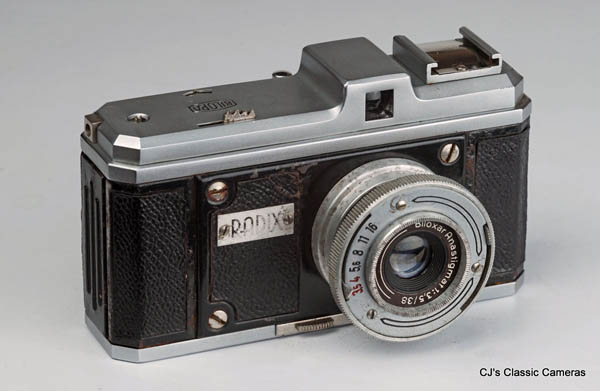
A Bilora Radix with Bilora Anastigmat 38mm f/3.5 lens in a single-speed shutter. Models with adjustable shutter speeds had a speed selector knob next to the lens where the Radix logo is. Despite its small size the camera was remarklably heavy, and a odd combination of high-quality and flimsy materials.
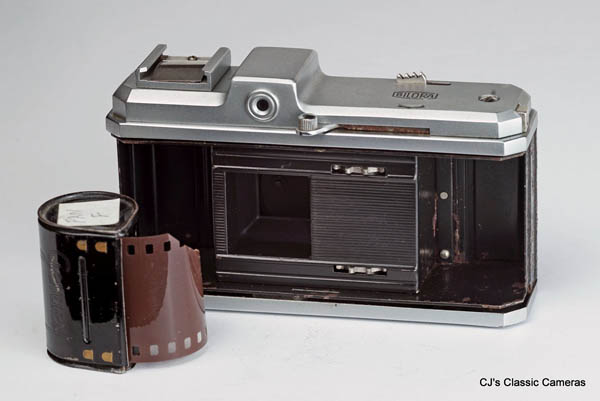
Rear view of the Bilora Radix with back removed. Note the square film frame. A loaded Karat cassette as used by this camera is also shown. An identical one was used as a take-up cassette.
Bilora Bella
Despite the Italian-sounding name, the Bilora Bella was a German-made camera (see Bilroa Radix above). The Bella was a series of simple rollfilm cameras in a wide range of designs, colours and film formats. The one here was produced around 1955 and is a striking 6x4.5 cm 127 rollfilm camera with bold shapes and colours. It has a lens of undefined focal length, two aperture settings f/8 and f/11, and an automatic shutter with two shutter speeds plus a B setting. It has a curved film frame like the Coronet. The large wind knob, which was integrated in the body, was quite pleasant to use compared to the smaller ones on most other rollfilm cameras. Cheap and cheerful!
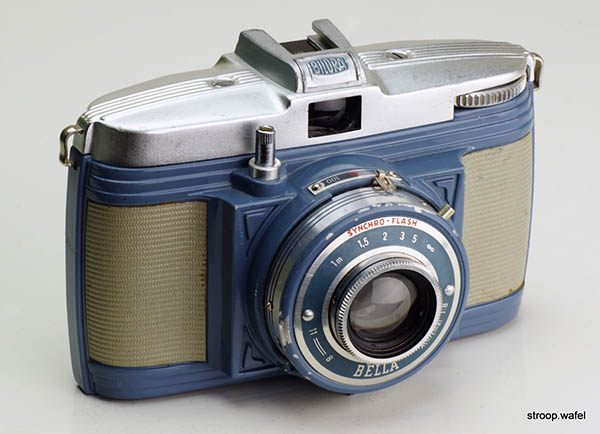
The blue version of the Bilora Bella.
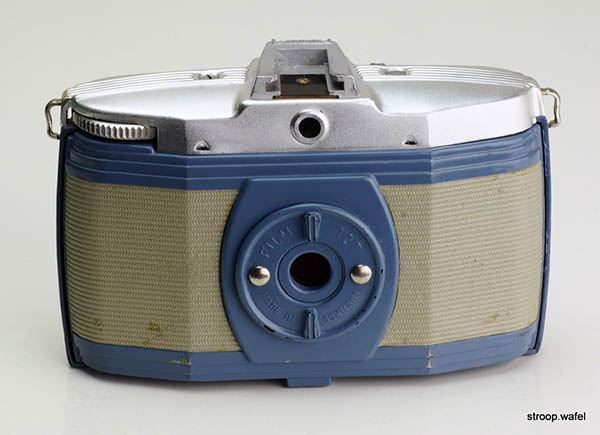
The backside of the Bilora Bella showing the large back release knob integrated with the spy window.
A slight modification of the above was the Bella 44, which was a 4x4 127 rollfilm camera. Otherwise the cameras were nearly the same, with identical shutters and handling features.
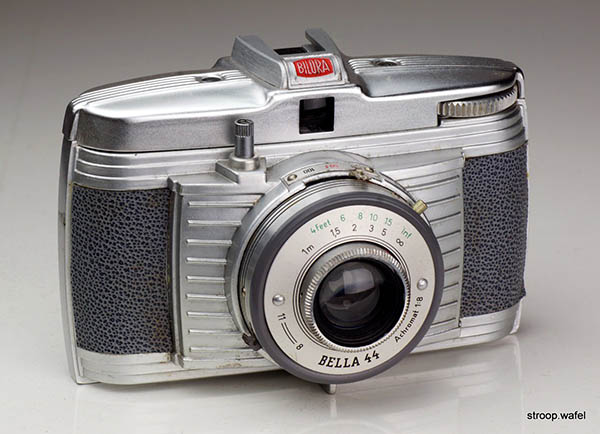
The Bilora Bella 44. Note the square viewfinder window compared to the rectangular one of the Bella above, reflecting the different frame formats the cameras use.
Zimmermann Luxette / Luxette 'S'
The Zimmermann Luxette and Luxette 'S' were simple but likeable cameras along the lines of the Bencini Comet and the Coronet Viscount. They were 127 rollfilm square format cameras with rather slow, coated fixed-focus meniscus lenses (fastest aperture of f/7.7) made by well-reputed Roeschlein Kreuznach, and home-build Cylux shutters with a choice of four speeds. The Luxette 'S' had additional flash synchronisation. The cameras had double-exposure prevention, and were all in all relatively well-featured compared to similar cameras. They were also sold under the name Cima 44 and 44S, which had added accessory shoes.
Precious little is known about the company that made the cameras, G. Zimmermann Abt. Kamerabau from Zirndorf, Nurnberg, which was a sheet metal working company that made a large assortment of household and other products from 1880 until 1972. Cameras were only a very small part of their assortment, in addition to the still cameras above they also build several 'Cima' movie cameras.
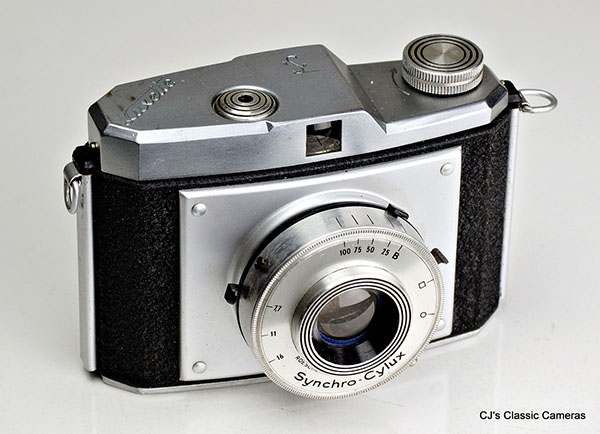
A Zimmerman Luxette 'S' with Roeschlein Kreuznach 50 mm f/7.7 Cymat in Synchro-Cylux shutter, its name engraved on top of the camera. The lens looks like it might have been collapsible but it is not.
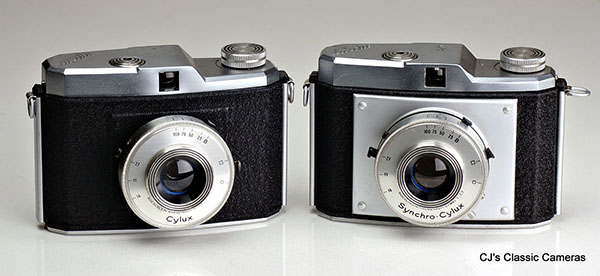
Zimmerman Luxette and Luxette 'S' side by side. The Luxette lacked the metal front trim of the Luxette 'S'.
Reporter (Vredeborch Felica)
The Vredeborch Felica was a simple but likeable rollfilm camera and probably one of the smallest medium-format cameras out there. It used 120 rollfilm to make 6x6 square pictures. It had a simple meniscus lens with three focus zones and only two shutter and aperture settings. It did, however, have a build-in yellow filter, indicating that this camera was mainly aimed at black and white photography. The camera had a curved back and film frame, a feature also found in other cameras with simple lenses, such as the Coronet Viscount, as lens deficiencies were easier to correct this way. It came with a carrying strap that would neatly fold away around the camera body. The viewfinder is a simple Galilean type but due to its length is defines the picture frame quite well.
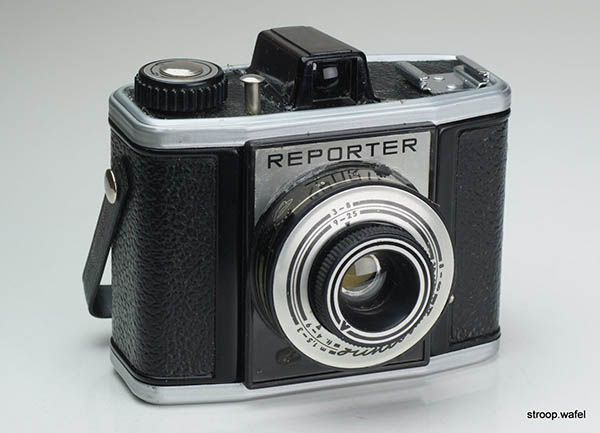
A Vredeborch Felica rebranded as Reporter and as such sold by the department chain Kaufhaus in Germany. It is occasionally called the Reporter Junior II because that's what it says on the shutter plate, but that is the name of the shutter. On this example the front cover beneath the lens is missing.
Vredeborch Felicette
Another camera from Vredeborch, this a 35mm one, the Felicette. Like the Felica, this was a rather simple camera with viewfinder, uncoupled lightmeter and two-leaf shutter with only three speeds. It didn't have a sprocket wheel to track the film transport, relying on a large drum take-up spool instead to minimise the unavoidable increase in spacing between frames.
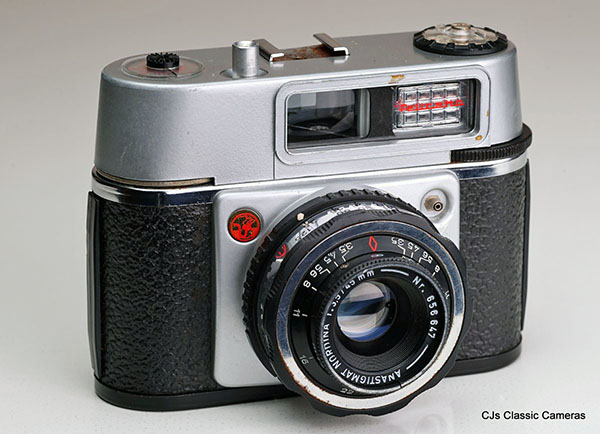
A Vredeborch Felicette with Nordina Anastigmat lens, a front-cell focussing three-element lens.
Venaret
The Venaret was a rather simple 6x6 camera for 120 film format. It was introduced in 1949 by Vena in Amsterdam. It had a very simple construction, dominated by the large boxy lens base which also held the self-cocking two speed shutter. The Venaret had an interesting feature, which was a hot shoe, only rarely found on cameras from that time (see the Finetta Super, coincidentally also designed by a Dutchman, and the Universal Mercury). I am not aware of Vena producing a matching flash, but cordless flashes were rare at the time. In any case, the camera did not sell very well and the company went bankrupt two years later. It was probably the poor build quality that let the camera down. Nevertheless, the concept of a large boxy front attached to a more regular 6x6 rollfilm body was not much later copied by the Coronet with their fairly popular Cadet and Flashmaster models, so perhaps Vena had been on to something!
Despite its small period of production, several different cosmetic variants were made, with different colour front plates as well as a green leather version. Variants without accessory shoe were called Venaret Junior.
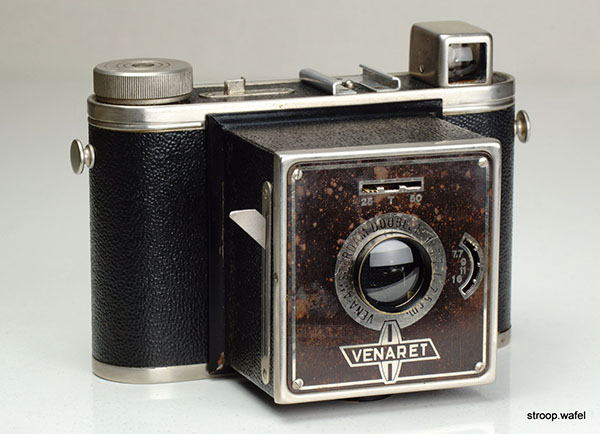
A Venaret with brown (originally probably black) front plate and a home-build Doublet 75mm f/7.7 lens. The front group consisted of two cemented elements (the doublet) but a third element was present behind the shutter. This is an arrangement different from a typical triplet and the optical quality was not great.
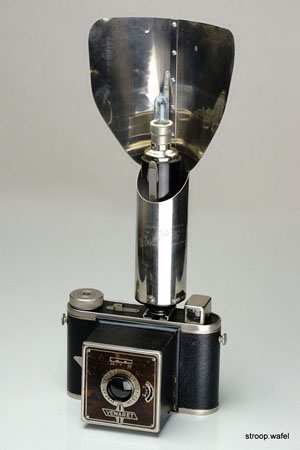
|
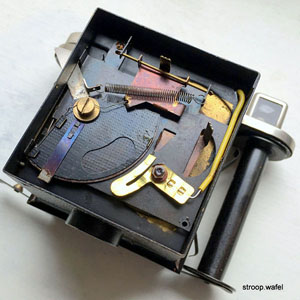 |
|
(Top) Shutter assembly of the Venaret, which is essentially a rotary shutter with a reduced throw. The yellow wire is the lead to the hot shoe.
(Left) Venaret with a cordless flash unit from Finetta, one of the few brands that supplied such flashes at the time.
|
|
An example of the Venaret Junior, the version of the Venaret without flash synchronisation and hot shoe.
|
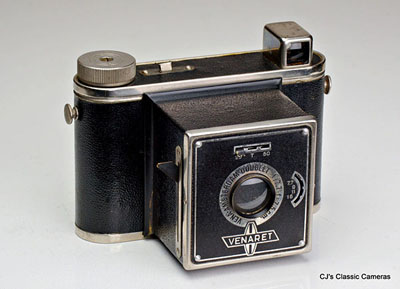
|
Tahbes Synchro Camera
We're staying with the theme of Dutch cameras (see Venaret above) and introduce the Tahbes brand. These cameras were made in a suburb of The Hague from just after WWII to around 1957. The somewhat awkward name was an acronym which included the name of the founders of the brand, Brockmeier and Steegers. The cameras were 6x6 collapsible lens cameras that used 120 rollfilm. The most common camera was the Synchrona, name presumably after its flash-synchronised shutter. The camera came with a dedicated flash unit and a hot shoe; the latter was a propriety screw-in type so incompatible with other flashes. The rarer Synchro Camera appears to be very similar to the Synchrona but had a polished metal body covering instead of leather and a simpler shutter and aperture. The Populair did not have a flash shoe and also had a simpler fold-up viewfinder.
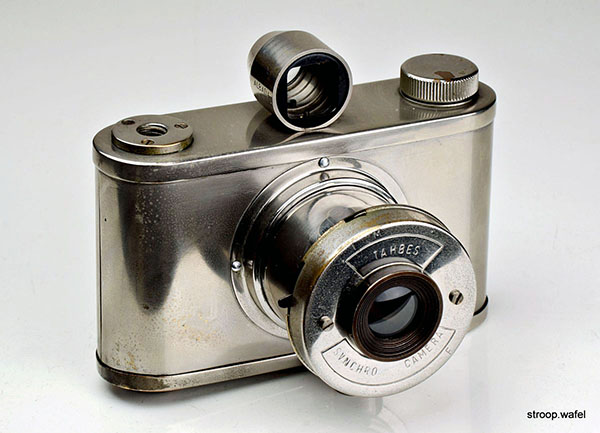
A Tahbes Synchro Camera in nickel-plated full metal cover and its characteristic Albada viewfinder. Note the flash mount on the top plate, which required a dedicated flash unit.
The cameras were quite simple otherwise, with a single shutter speed, a T setting and two aperture settings by swivelling in and out a metal blade with a circular hole. The main talking point of the camera probably was its impressive Albada viewfinder, which provides a 1:1 view not unlike the SBOOI Leica 50mm viewfinder. It is, however, of much simpler construction, consisting of a single special-cut glass element as the eye-piece and a flat piece of glass with a square mask at the front. The eye piece element has a centre part of flat glass, so the view is in fact like looking through a lens-less frame finder, which is what gives the 1:1 view. The edge of the eye piece element brings the frame edge into focus, but here the view of the subject is blurry. A finder similar to the one on the Tahbes was produced by Old Delft, which (based on images I have seen) worked according the same principle. This finder differs from what is more commonly considered an Albada finder, which has a half-silvered front element that reflects frame lines painted on the eye piece (which coincidentally is how the Leitz SBOOI finder works).
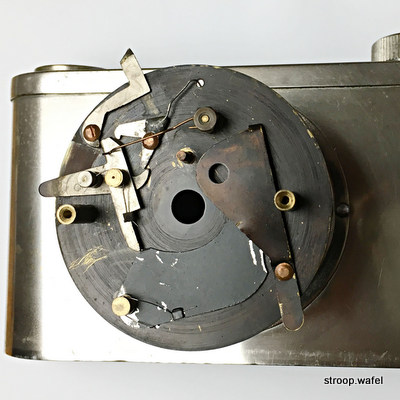 |
Shutter mechanism of the Tahbes Synchro Camera, here open at its T setting.
|
Frankarette / Super Frankarette
Franka Kamerawerk from Bayreuth was probably best known for its Solida range of folding cameras, like the Solida IIIE above, but it did also produce a small range of rather middle-of-the-road35mm view- and rangefinders, the Frankarettes. Visually they were probably most comparable with the Agfa Silettes. A few of the models came with light meters.
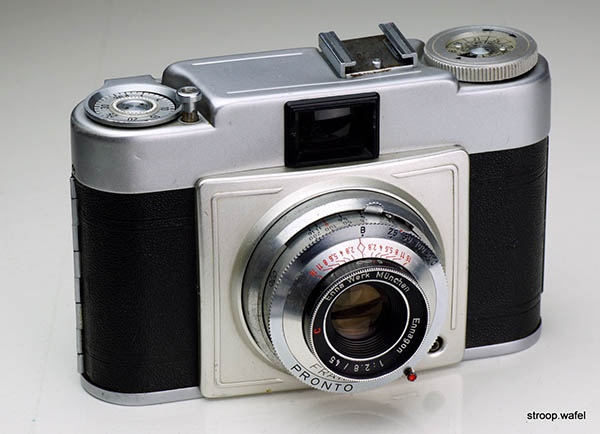
Frankarette with Enna Werk Ennagon 45mm f/2.8 lens in Pronto shutter.
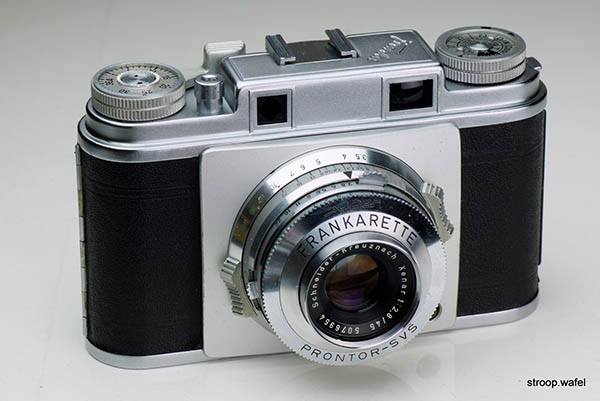
Super Frankarette with Schneider-Kreuznach Xenar 45mm f/2.8 with Prontor-SVS shutter.
WZFO Fenix
WZFO (Warsaw Photo-Optial Works) was a Polish photographic equipment company that was founded in the early 1950s. Their first camera was the Start, a pseudo TLR with home-build shutter and lenses. Soon followed a small range of 35mm cameras, the Fenix range. The Fenix I and Ib were viewfinder cameras, the later with a projected brightline frame, whereas the Fenix II and IIb were split-frame rangefinders. They were all equipped with the same lens and shutter, in fact the cameras were of very similar build. However, the Fenix-I and II were designed to use uptake cassettes, so missed a rewind mechanism.
Although the build quality of the cameras was not great, they had several interesting features, such as a helical focussing system and a small wheel at the back indicating if the film was advanced properly. Somewhat unusual was that the film advance lever was on the left and the viewfinder on the right. Internally, the shutter was cocked through a string guided by a pulley, which was a weakness in the system and may explain why most Fenix these days have non-working shutters.
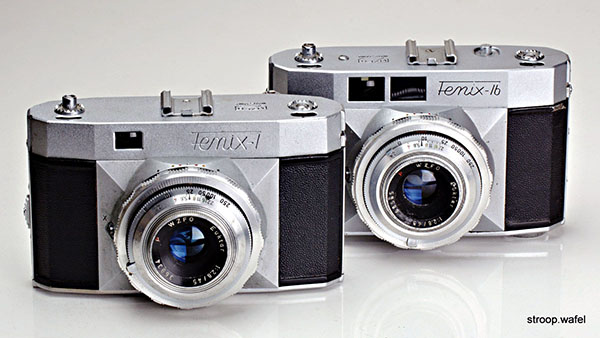
WZFO Fenix-I and Fenix-Ib, both with Euktar 45mm f/2.8 lenses.
The Fenix II was the rangefinder version and was clearly inspired by the Agfa Karat 12, as it had the same style of 'misaligned' rangefinder windows, the rangefinder itself being of the split-mirror type. Except on the Fenix the alignment was opposite of that of the Karat. The rangefinder itself looks like it was also copied from the Karat 12, as it has a similar design: a large prism with a moving wedge in front of one of the windows, and the eye piece in-between at the back. Here the similarities end, for the rest it was similar to its viewfinder companions described above.
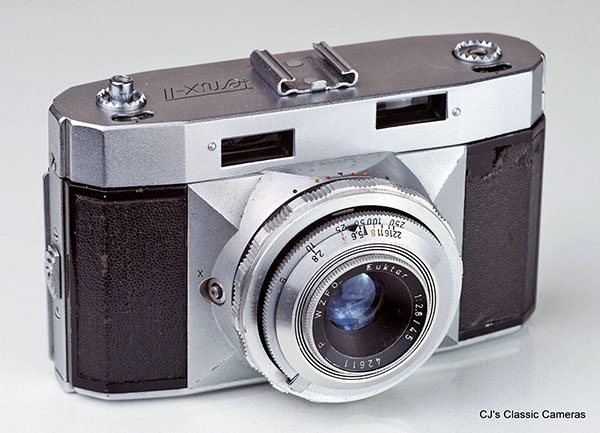
WZFO Fenix-II with Euktar 45mm f/2.8 lens in somewhat shabby condition, but it works!
Pentona II
The 1963 Pentona II is a bit of a strange one, it was apparently designed by Zeiss Ikon but produced by KW in Dresden, Germany, better known for its Praktina range of SLR cameras and later absorbed by VEB Pentacon. It is rather simple, its defining features being the very large bright line viewfinder and the wind lever. The very simple Priomat is a two-bladed leaf shutter of the self-cocking type. Nevertheless, for some reason this camera has made it into the National Media Museum in Britain, amongst other cameras of considerably higher calibre.
It is not easy to see, but this model has a Pentacon symbol on its front (bottom left while looking at the camera). The Pentona I comes with either of two symbols, a square with KW or a Pentacon. As KW stopped being an independent company in 1959, this presumably means that the Pentona II was in fact built by VEB Pentacon, or rather its precursor VEB Kamera- und Kino-Werke Dresden. The Pentacon symbol was derived from the Ernemannturm, a famous landmark in Dresden built in 1922-23 as part of the Ernemann factories, one of the founders of Zeiss Ikon.
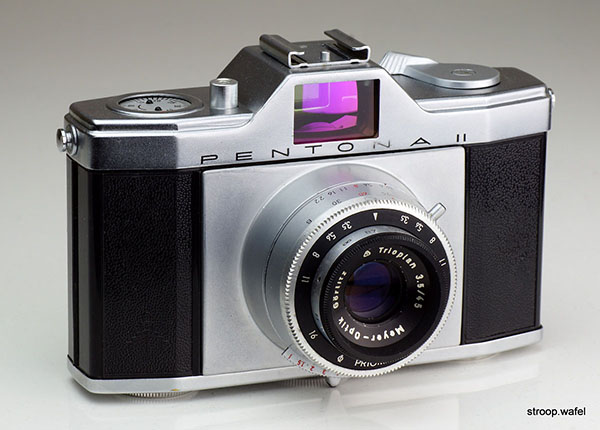
A Pentona II with Meyer Trioplan 45mm f/3.5 lens.
Steiner Steinette (Hunter 35)
The 1950 Steinette was a very small and simple 35mm camera with an unspecified self-cocking shutter build by Steiner, which was (and still is) a German optical company from Bayreuth that produced few lenses and even fewer cameras. It was sold as Hunter 35 in the U.K. Early production Steinettes had 3-speed shutters, later production a 4-speed shutter. It had a wind knob with a little lever which worked well as it needed only half a turn to cock the shutter and wind the film. On the back it had an exposure table to which the pressure plate was attached. Once removed it would expose the film gate, convenient for checking the lens, shutter and aperture. The lens was a coated Steiner 45mm f/3.5. A peculiar feature of the camera was the lack of a sprocket wheel, so the spacing between the film frames would increase the more pictures one took (see here for an explanation). The camera came with a dedicated large diameter wind spool, presumably as to limit the effect of increasing frame spacing.
Other than Hunter 35 the Steinette was also sold as Brelland and Tanette; apart from the name engraved on the lens base they appear to be identical. There is also a very rare uncoupled rangefinder version of the Hunter 35.
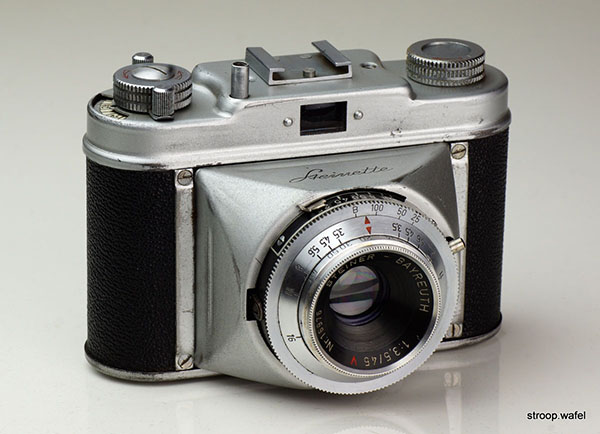
A Steiner Steinette with 3-speed shutter and Steiner Bayreuth 45mm f/3.5 lens.
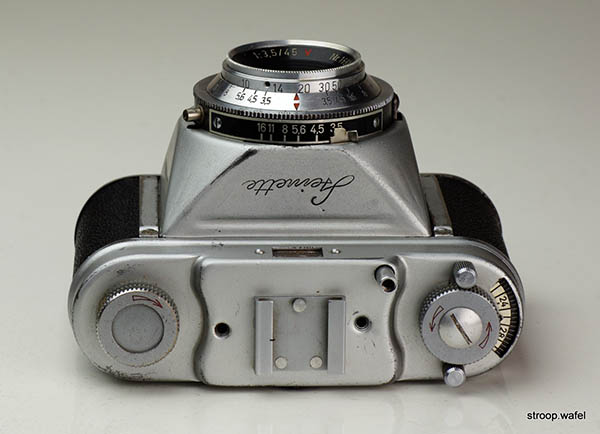
Top view of a Steinette showing its characteristic lens base engraved with the camera name.
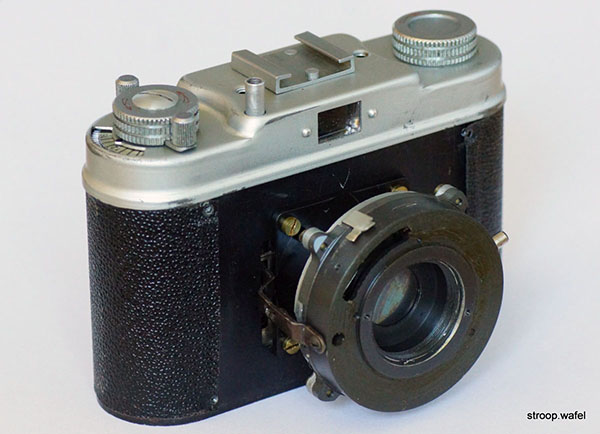
A Steinette with its lens base on shutter plate removed. The lever at the left of the lens is the shutter release which pivots around the retaining screw mounted on the shutter housing.
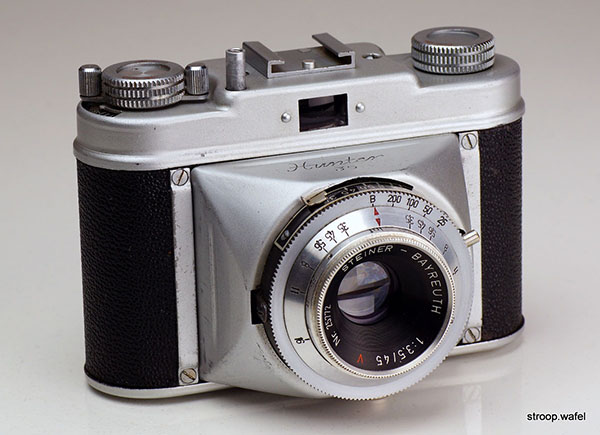
A Steiner Steinette rebranded as Hunter 35 with Steiner lens. It differs from the Steinette above in a few details, it has a small rewind lever at the back, the screw in the wind knob has been replaced by a small nut and the frame counter is black instead of white. This example also has a shutter with an extra 1/200 shutter speed, but earlier ones had the same shutter as the Steinette above.
A rangefinder version of the Hunter 35 also existed. It had a non-coupled rangefinder with a distance dial in front of the rewind knob. It appears that no rangefinder version of the Steinette itself was ever built.
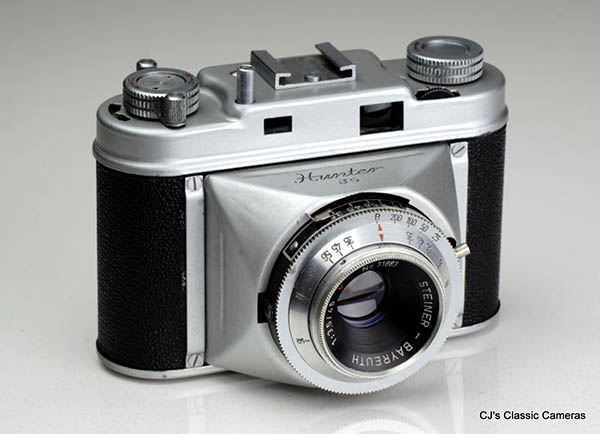
A Hunter 35 RF, the rather rare rangefinder version of the Hunter 35 above.
Ideal Color 35
The 1954 Ideal Color 35 was a rebranded Nixon. Camera-Werk Nixon (previously Gerlach) in Wuppertal, Germany, made only few cameras, perhaps the most well-known was the Nixette/Trixette, a folding camera with a unique strut and bellows mechanism. A very similar camera with collapsible lens was sold under the name Ideal. The Ideal Color 35 was clearly related to the Steinette above but came with redesigned top housing which featured a wind lever and a large integrated wind knob. The lens was a Nixon-Anastigmat 45mm f/3.5 which perhaps is a rebranded version of the Steiner lens found on the Steinette. Curiously, all Ideal Colors have the same lens serial# 28505. Like the Steinette, it lacks a sprocket wheel but has a large dedicated wind spool. It is slightly different from the one of the Steinette so cannot be interchanged. The shutter was even simpler than the one on the Steinette, lacking the 1/200 speed. It was also sold as the Forette/Forelle.
How Nixon got to make a camera very similar to the Steinette is not well documented. Perhaps Steiner sold the rights and possibly even manufacturing equipment to Nixon after their short diversion into the camera business.
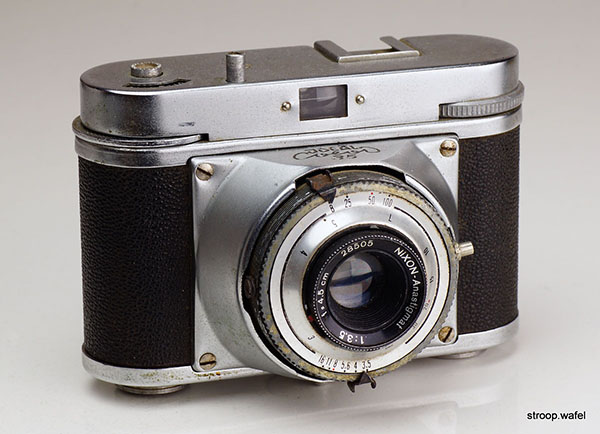
Ideal Color with Nixon-Anastigmat lens.
Nedinsco Primo
The third and final reincarnation of the Steinette was the Nedinsco Primo, produced in the Netherlands from around 1958. It was in fact more similar to the Steinette than the Ideal Color, the main difference being the addition of a wind knob and the location of the accessory shoe (on a later version). The lens collar was also slightly different. The lens was a Nedinsco 45/3.5, most likely produced by Nedinsco itself as it was (and still is) an optical company initially founded by Carl Zeiss Jena in 1921. A few very early cameras were equipped with a Futura Bracht lens.
An early version of the Primo had no lens serial# but a later version did. There was also a rare version with grey leatherette. On the back was a removable plate but it did not have the exposure table printed like on the Steinette. Curiously, on the Nedinsco website features a picture of a camera identical to the Ideal Color but with a Nedinsco lens. It appears that this was a camera produced by Nedinsco as the Argus around 1957, before it introduced the Primo.
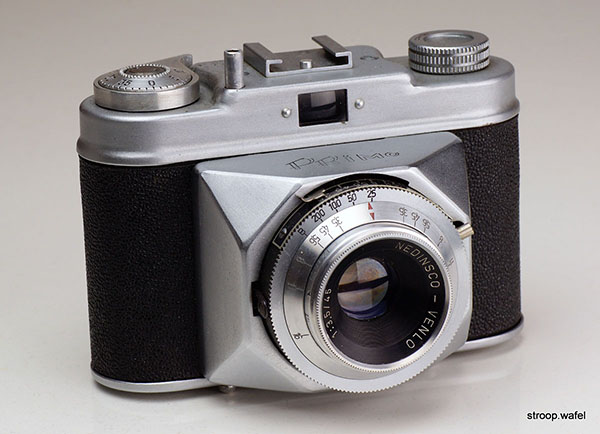
An early Nedinsco Primo with Nedinsco lens without serial number and accessory shoe in the middle.
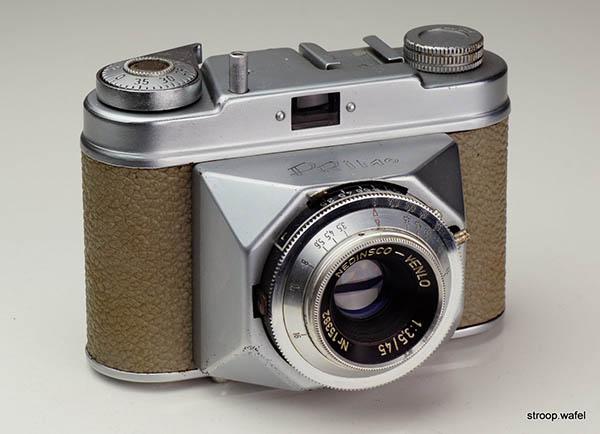
Rare grey version of the Primo with a lens that includes a serial # and recessed accessory shoe. I am not sure if they are rare because of there weren't many build or because collectors hold on to them. The range of lens serial numbers is at least as large as the range of the later black version.
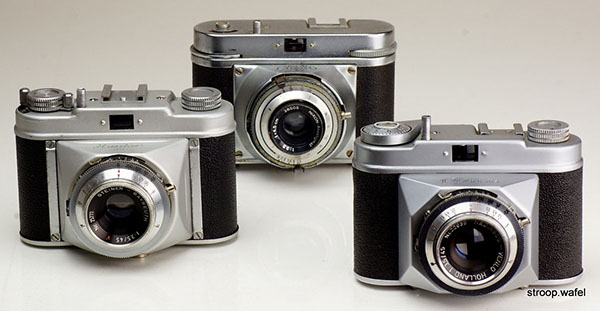
The whole 'Steinette family': a Hunter 35 (rebranded Steinette), an Ideal Color and a Nedinsco Primo. The latter is the later version with lens serial# and recessed accessory shoe.
Rollei B35
The Rollei B35 was the little brother of the iconic Rollei 35. Little as in, less well featured, as the cameras were about the same size.
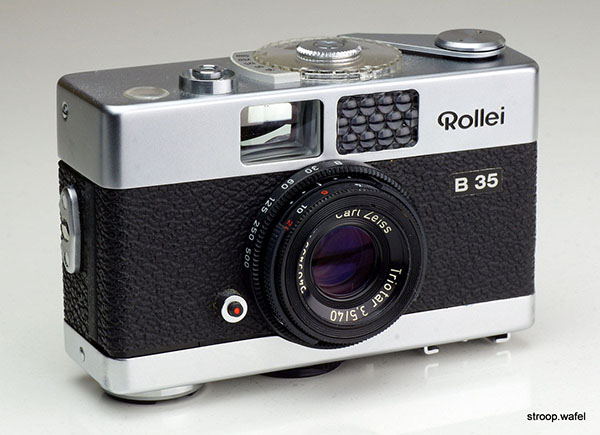
Rollei B35 with CZ Triotar 40mm f/3.5 lens. The shutter had to be cocked before extending the lens.
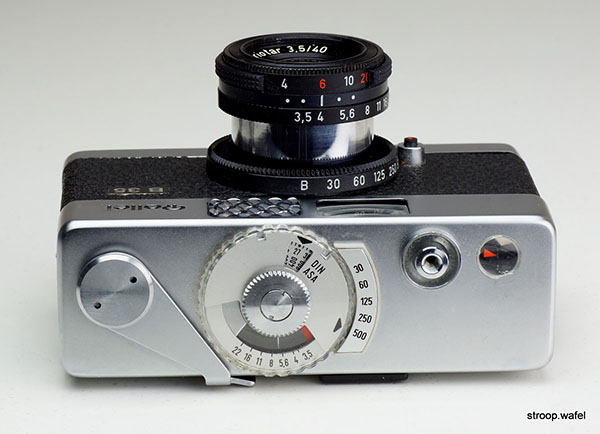
Top view of a Rollei B35 with its collapsible lens extruded, showing the lever winder, comparatively large light meter unit, frame counter and release button.
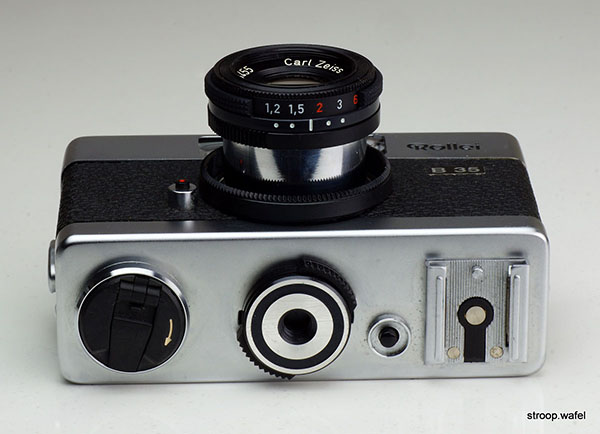
Bottom of the Rollei B35 with rewind crank and accessory shoe, a rather odd position but the only place still available.
KMZ Horizont
The KMZ Horizont is a very unusual camera which makes wide-angle panoramas by rotating its lens on a turret whilst exposing a strip of film. This is in fact very similar to the panorama mode found on many digital cameras/phones nowadays. Everyone who has used this mode knows that funny things can happen when objects move whilst you're making the panorama, and that strange distortions can happen to things with straight lines. It was no different with the Horizont, as the film wasn't exposed at once, but gradually from left to right whilst the film gate was rotating in front of it. To avoid warped lines it was best to keep the camera exactly level, and it did therefore come with a viewfinder that showed a bubble level in its field of view.
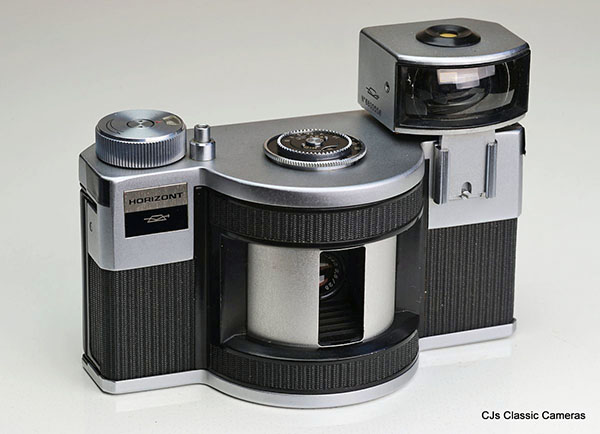
A KMZ Horizont with ОФ-28П 28mm f/2.8 lens. The panorama photos it produced were 24x58, which has an aspect ratio of about 2.4:1.
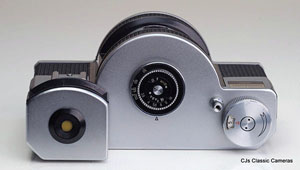
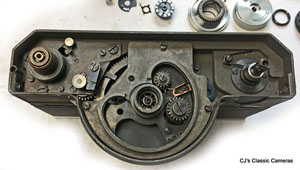
(left) Top view of the KMZ Horizont showing the bulging film turret. Aperture and shutter speed controls were in the centre above the turret. Note the bubble level on top of the viewfinder. (right) Horizont with top plate removed, exposing the shutter mechanism. The turret was fitted with ball bearings to smooth its rotation, as any variation would result in vertical stripes on the film. This is unfortunately a common problem with this models.
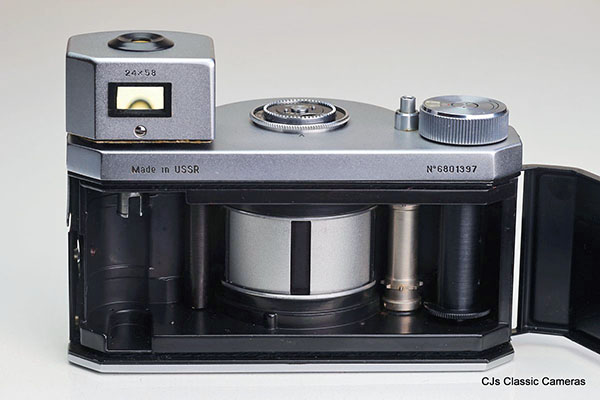
Inside view of KMZ Horizont. The shutter speed was controlled by narrowing a slit in front of the film gate and keeping the rotation speed of the turret the same for all shutter speeds. Note the curved film plane.
GOMZ Smena
The GOMZ Smena was a Russian-made 35mm viewfinder camera largely made of bakelite and somewhat reminiscent in design of the early Olympus Pen cameras, although it actually predated these, as the Smena was introduced in 1953. It was small, cheap but reliable and became wildly popular, resulting in a long range of models in many shapes and forms and a long history, eventually resulting in LOMO (see below). A distinctive feature was the lack of a rewind knob, so the camera needed to be used with an uptake cassette. GOMZ also made more advanced cameras, including the magnficent Leningrad (named after the city it was made) elsewhere on this site.
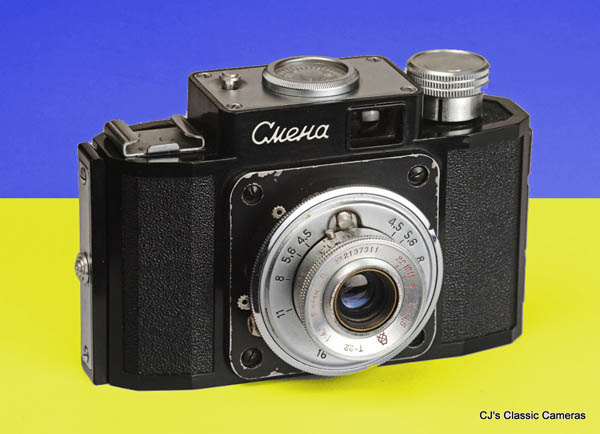
Although this is not a political site and I generally avoid social commentary here, I can't stay silent in the face of the atrocities the Russian army is inflicting on the people of Ukraine. To the Russian people: you may be told a very different story by your state media, but your leaders are waging an unjustified war under false pretences against a sovereign nation and your army is complicit in war crimes and killing innocent civilians, including women and children. To the Ukranian people: we stand by you. We have watched in horror the incomprehensible events that are unfolding, we admire your bravery and mourn your suffering. Freedom will come. #FreeUkraine
LOMO Cosmic 35
The LOMO Cosmic 35 was a simple viewfinder camera largely made of plastic from the late 1960s. It had a rather slow 40mm f/4 lens and a shutter with a rather limited range of speeds, plus a film advance knob instead of a wind lever. It was a name variant of the Smena 8. The Smena were a range of cameras of many shapes and forms and a long history, originally made by GOMZ (see above for an example), but around the Cosmic 35 changed to LOMO. LOMO is of course the orgin of the term lomography, a retro style of photography based on cheap plastic cameras (like the Cosmic 35), which was turned into a brand.
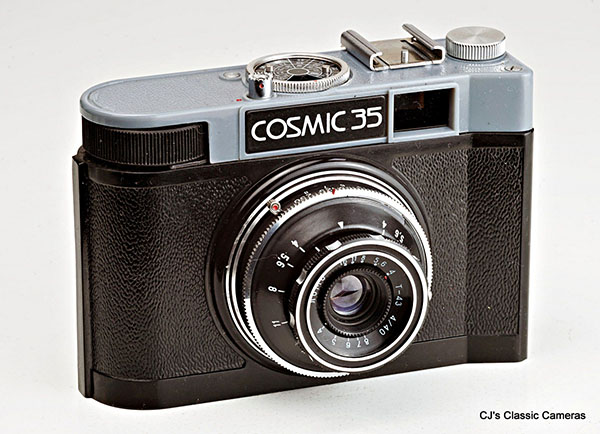
A LOMO Cosmic 35 with ПOMO T-43 40mm f/4 lens.
LOMO 135BC
The LOMO 135BC was a small 35mm viewfinder camera with a springwind motor. It was somewhat reminiscent of the Rollei B35, but would also fit straight in with the motorwound Ricoh models of a decade earlier (late 1960s). It's rather uncommon, at least here in the UK, but it's a sympathetic little camera with a decent lens that's easy to operate. It was a manual exposure camera but included a smart exposure calculator built into the wind knob.
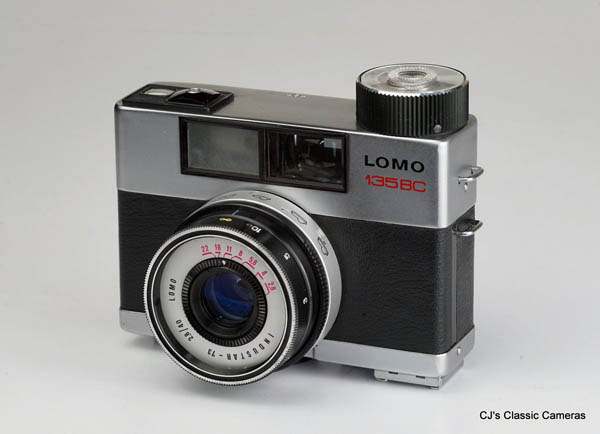
A LOMO 135BC with LOMO Industar-73 40mm f/2.8 lens. Note the large wind knob for winding the spring motor, which once fully wound would allow you to take about 8 shots in a row.
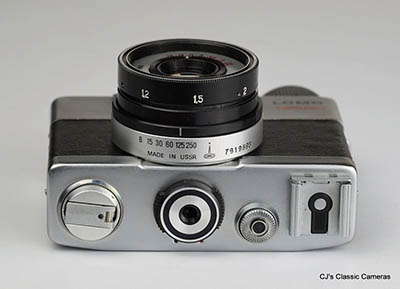
| |
Bottom view of a LOMO 135BC showing the rewind knob and flash shoe located here, very similar to the layout on the Rollei B35.
|
Gevaert Gevalux 144
Gevaert was a photography company from Belgium best known for its photographic paper and film supplies, but it also made a small range of fairly simple cameras. Simple was certainly a good description of the Gevaert Gevalux 144, but there's something likeable about the toy-like design of this camera. It was made of plastic and used 127 roll film. It came with a removable flash unit that could be operated with 15 V batteries, which were popular at the time, or 1.5 penlite batteries. It had simple specifications, two aperture settings and a fixed shutter speed. The lens was a simple meniscus, the camera had a curved film plane to compensate for some of the lens' deficiencies.
In 1964 Gevaert merged with Agfa, the new company being Agfa-Gevaert.
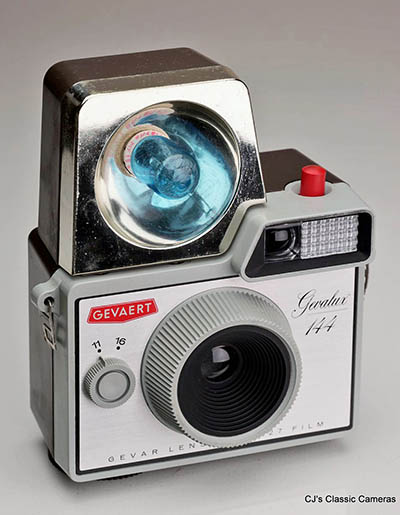 | |
Gevaert Gevalux 144 with Gevar lens and flash unit attached.
|
| 
